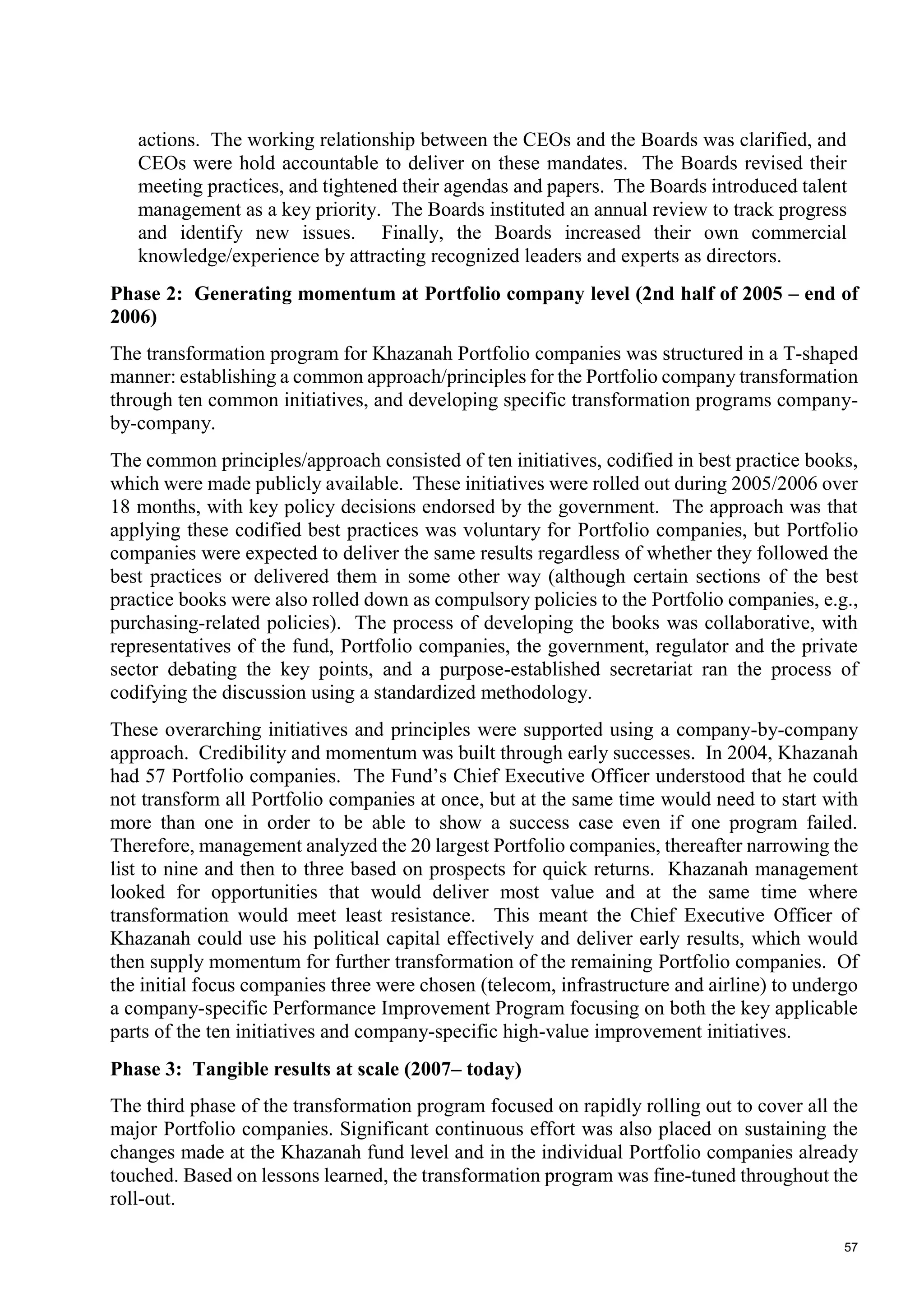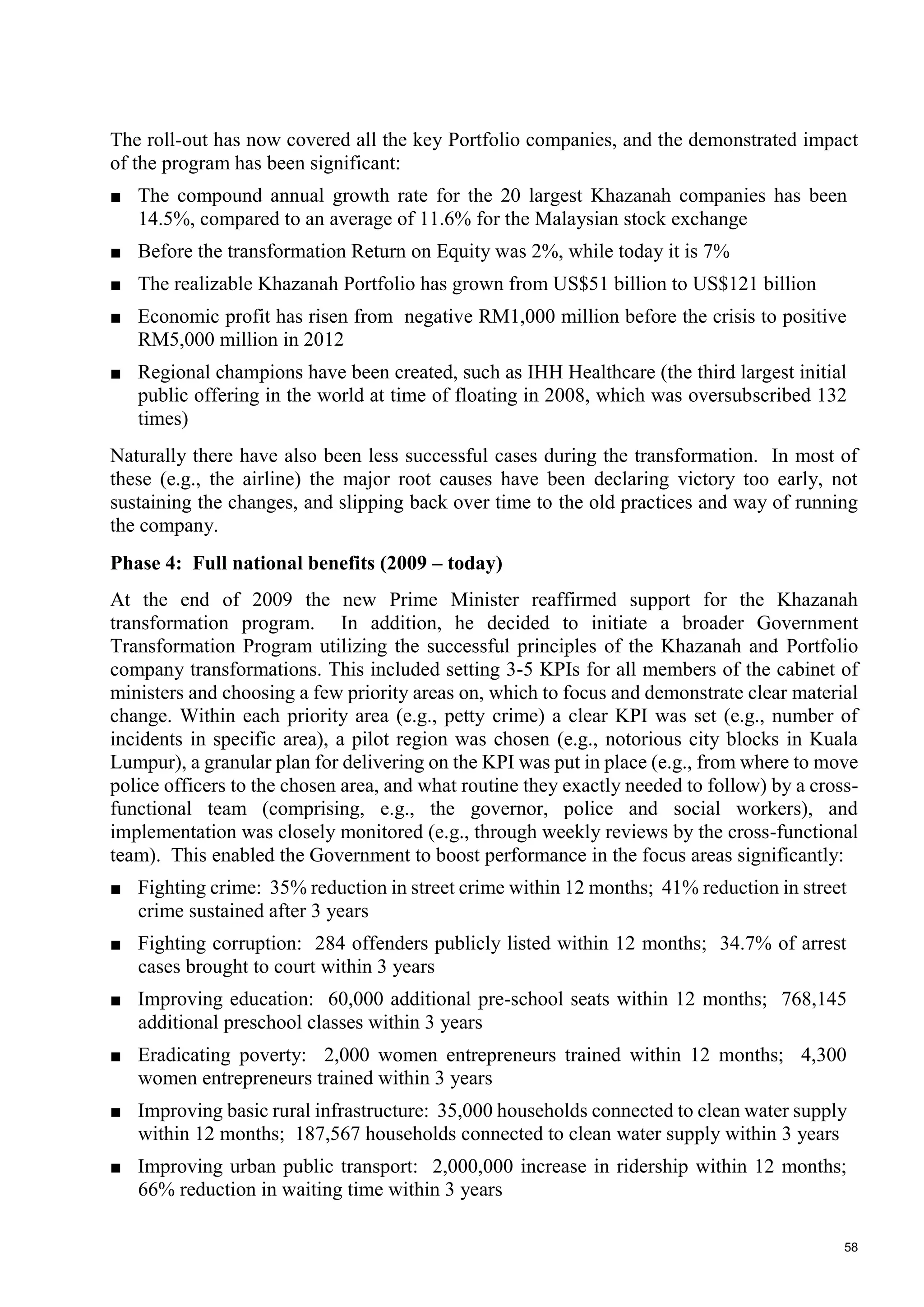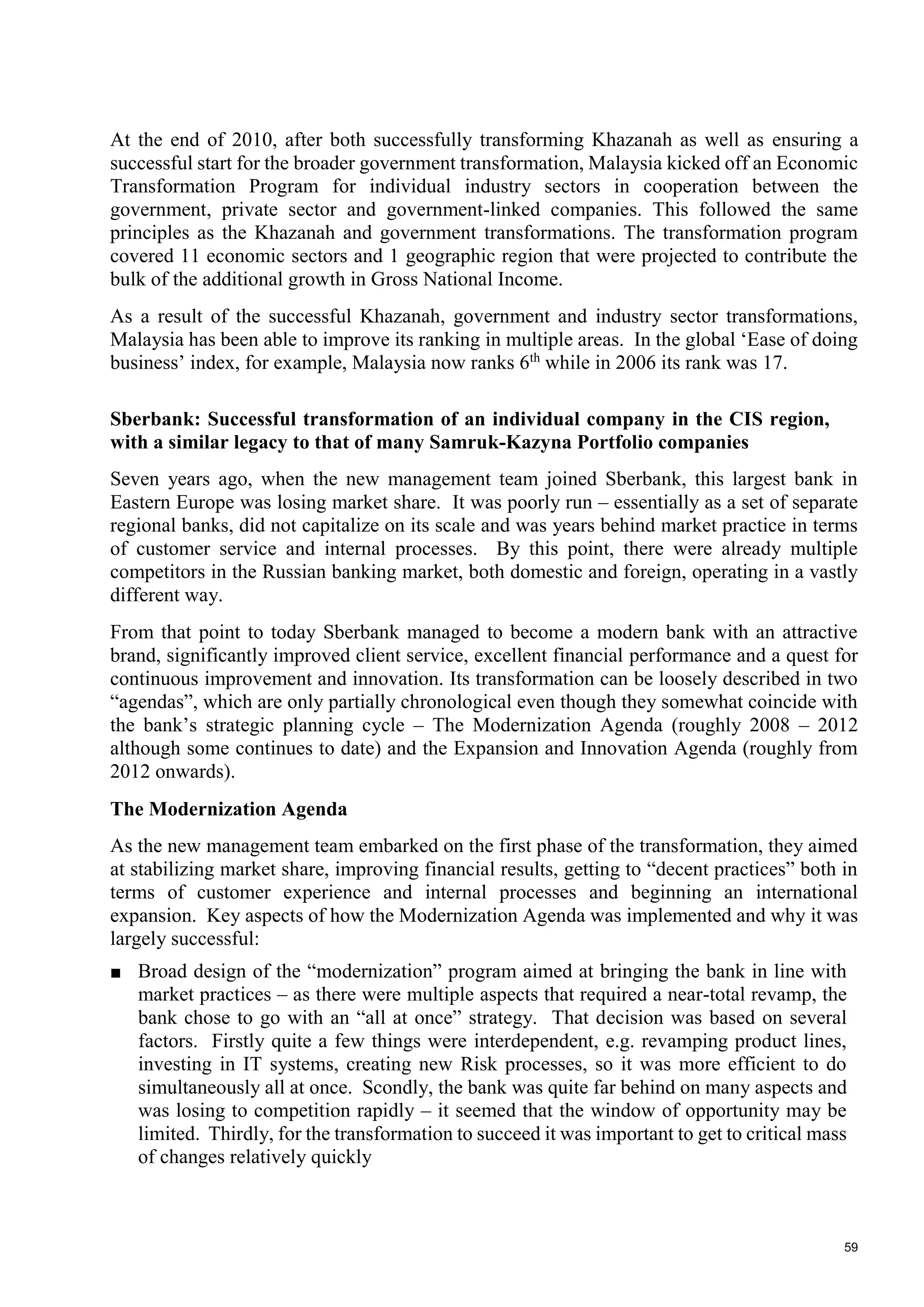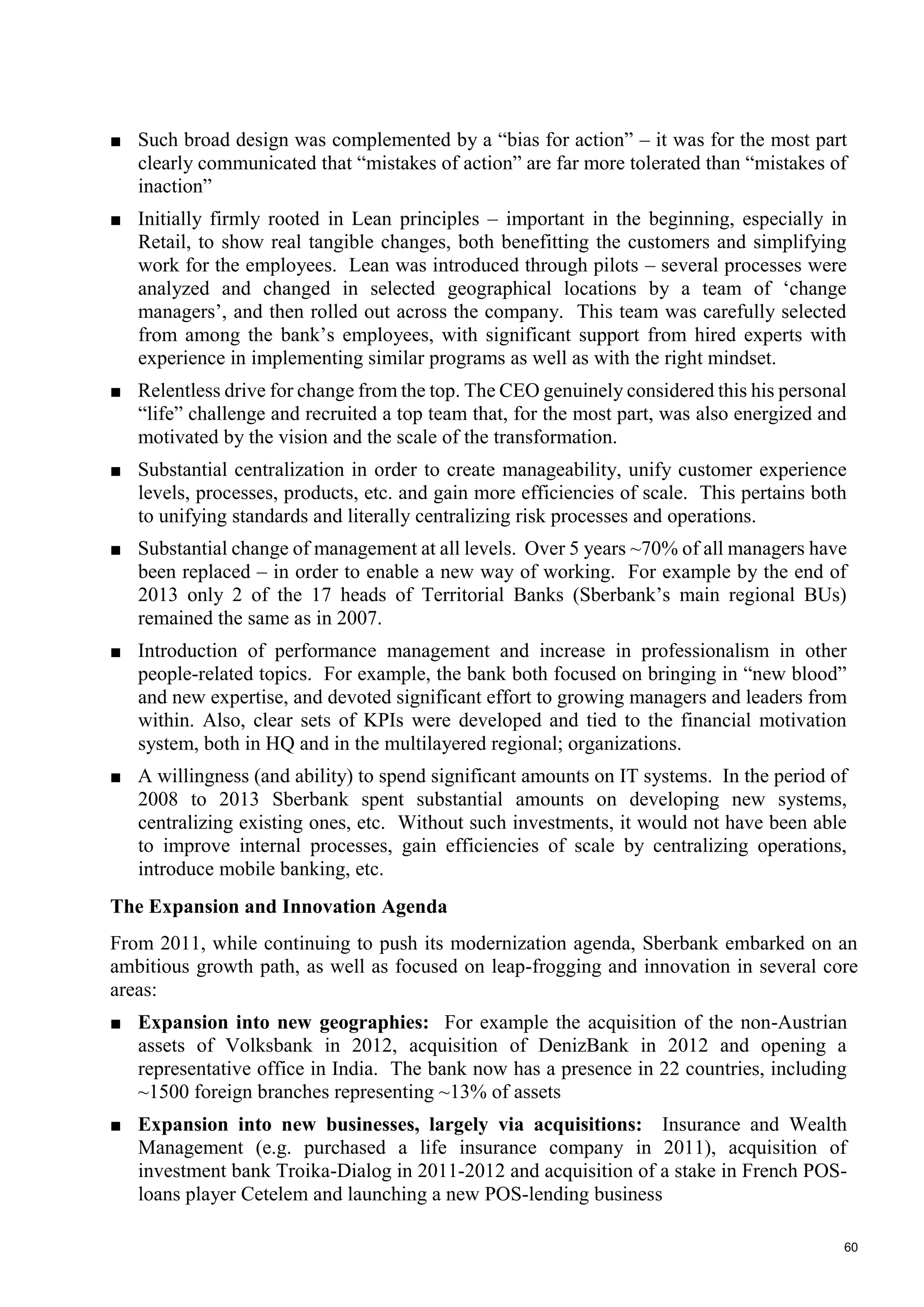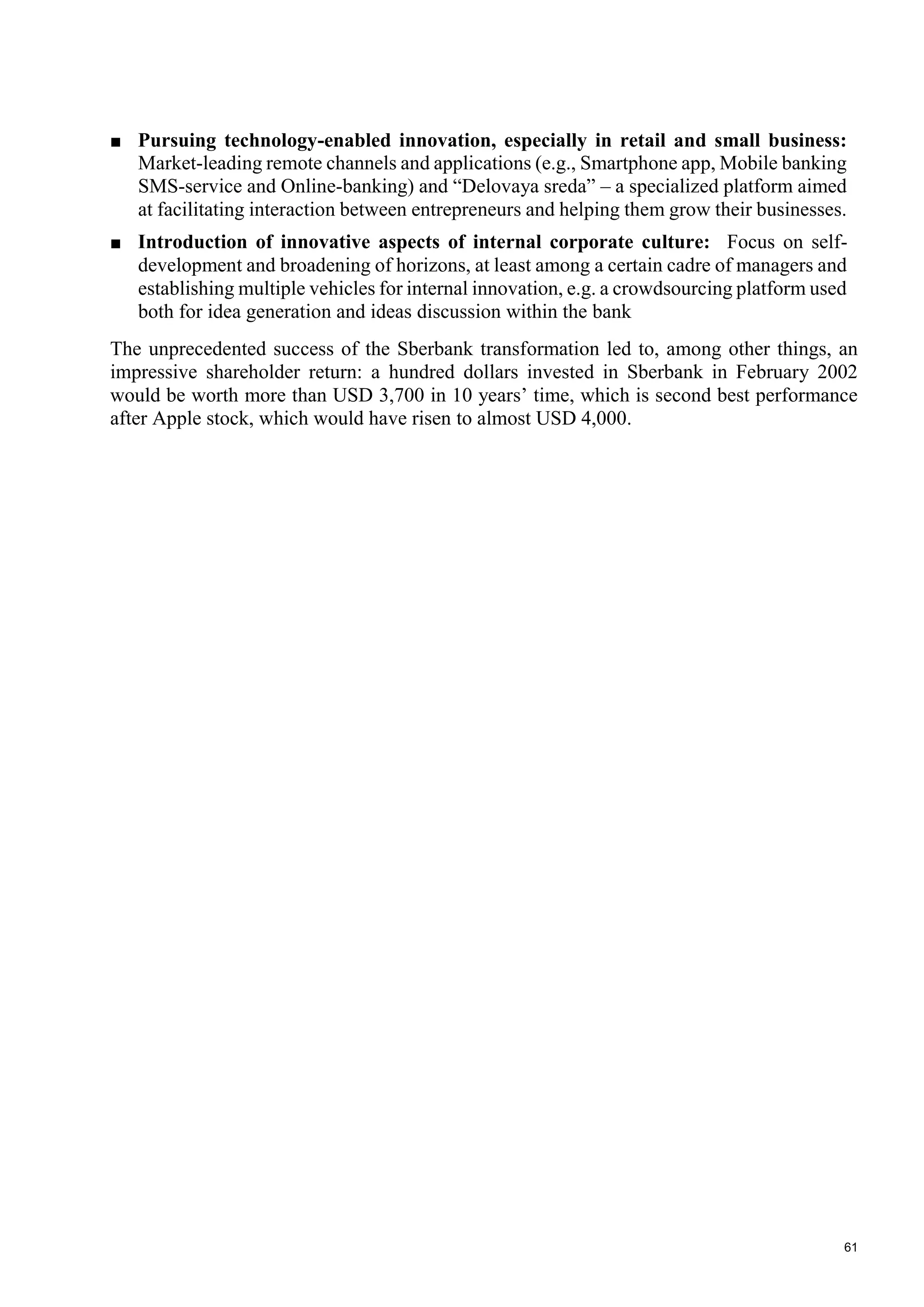This document outlines the need for a large-scale transformation program at JSC Sovereign Wealth Fund Samruk-Kazyna. It notes that Kazakhstan's development strategy aims to become a top 30 developed nation by 2050 but this will require a major breakthrough in investment growth and productivity. Samruk-Kazyna owns key national assets and must improve operational and investment performance to help achieve this goal, but current targets are insufficient. As a result, Samruk-Kazyna has developed a transformation program focused on improving value in portfolio companies, restructuring the portfolio, and reforming governance.
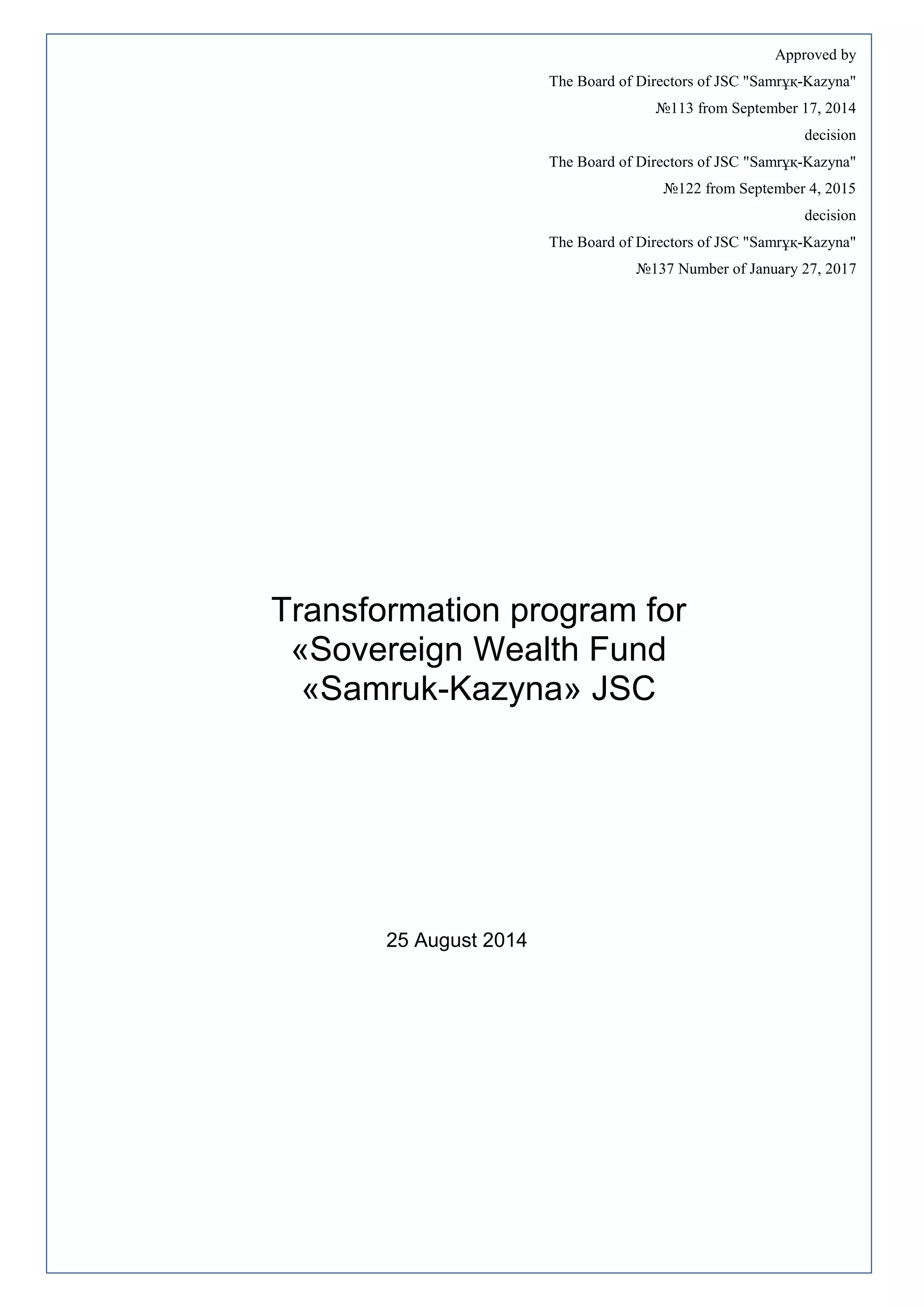
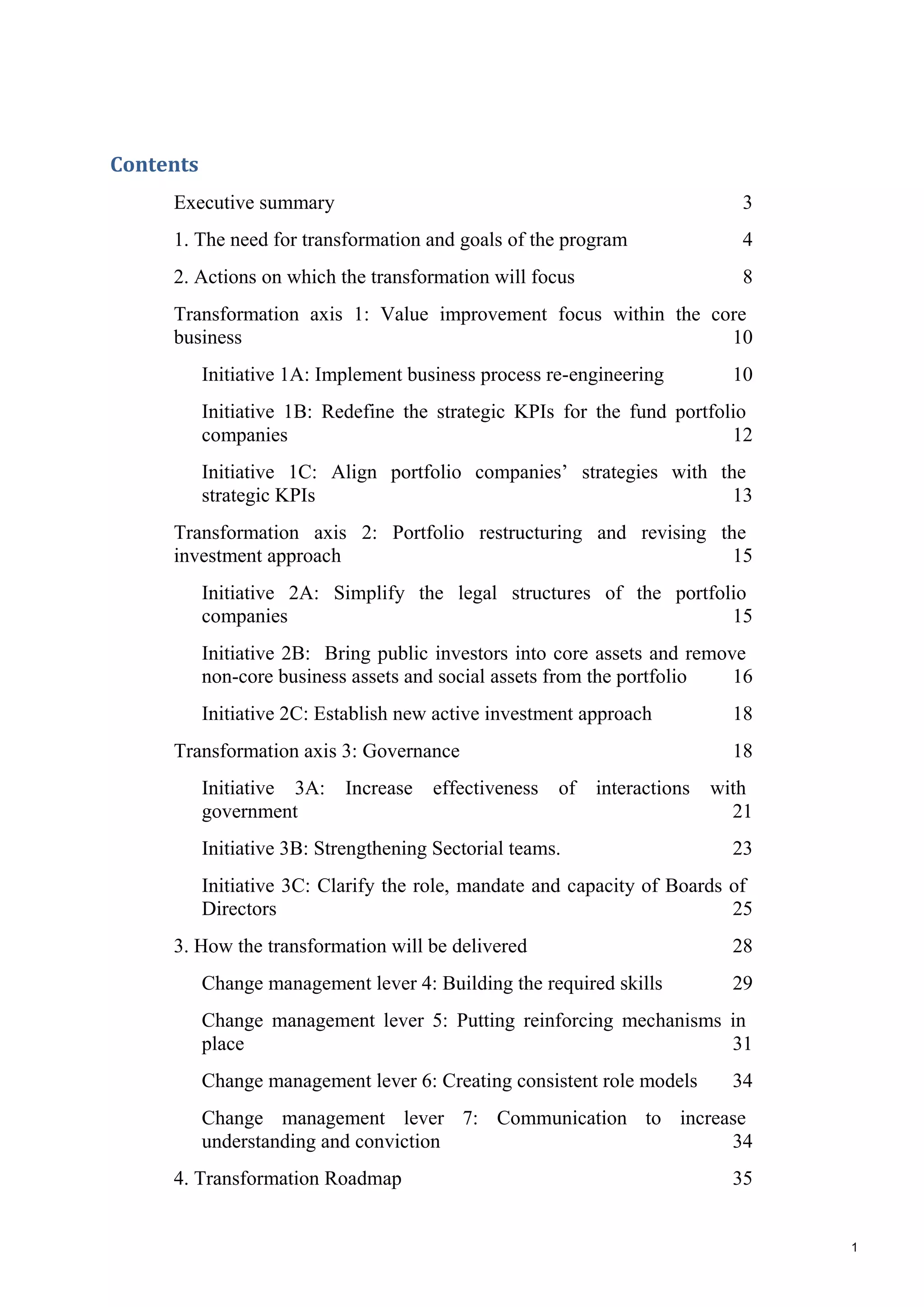
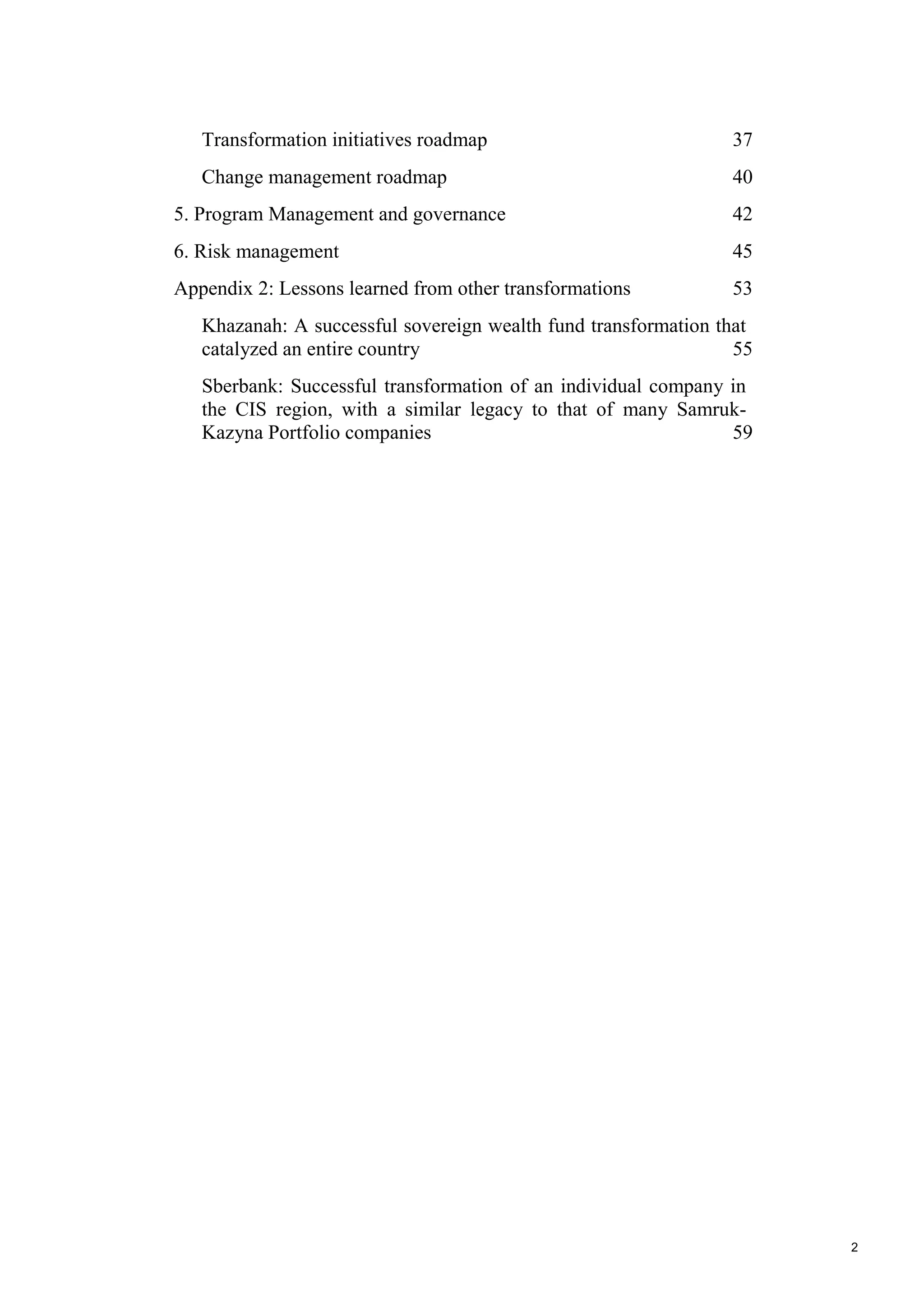

![4
1. THE NEED FOR TRANSFORMATION AND GOALS OF THE PROGRAM
Key messages of this chapter:
■ ‘Kazakhstan 2050 Strategy: New Political Course of the Established State’
outlines the aspirational target of becoming a top 30 developed nation.
■ To achieve this aspiration, Kazakhstan needs a major breakthrough in terms of
investment growth and improved productivity of existing assets.
■ Samruk-Kazyna owns a number of key assets in Kazakhstan and plays a critical
role in making such a step-change happen.
■ The Fund’s and portfolio companies’ operational and investment performance
targets are not sufficient to deliver on the state strategy.
■ To deliver the required improvement in operational and investment
performance, the Fund has developed a program of large-scale transformation
of itself and of the portfolio companies it controls (“Transformation program of
JSC Sovereign Wealth Fund Samruk-Kazyna”).
In ‘Kazakhstan 2050 Strategy: New Political Course of the Established State’, President
Nursultan Nazarbayev has set the main goal to enter the list of the world’s 30 most developed
countries. As Kazakhstan implements this aspirational development strategy over the next
35 years, it can build on a number of important advantages:
■ A comparatively young and well educated population, providing an excellent basis for
rapid labor productivity improvement
■ Substantial natural resources, creating many attractive investment opportunities in
sectors with high value add
■ Large neighboring markets (e.g., Russia and China) for the additional products and
services produced in Kazakhstan
All these advantages have already had a significant positive impact on Kazakhstan’s
economic development, with average annual real GDP growth of 7% from 1997 to 2012.
Nevertheless, the base case scenario (drawing on the current development trajectory and
existing development plans) demonstrates that continuing what Kazakhstan is doing today is
not going to be enough to achieve the aspirational 2050 target. Kazakhstan risks falling into
the middle income trap – when a country fails to surpass a certain income per capita due to
insufficient investments, high dependence on raw material exports, and shortage of skilled
labor.
In the last 50 years, of 100 countries that achieved middle income status, only 13 (Japan,
South Korea, Taiwan, Singapore, Hong Kong, Israel, Ireland, Spain, Mauritius, Portugal,
Greece, Puerto Rico and Equatorial Guinea) have managed to break through and enter the
high income group of countries. Kazakhstan has been doing well so far, as China, Panama
and Kazakhstan are among the few countries whose historical growth has consistently been
above that required to become an OECD country by 2050 [Figure 1].](https://image.slidesharecdn.com/samruk-kazynatransformationprogram-170203091723/75/Transformation-program-5-2048.jpg)
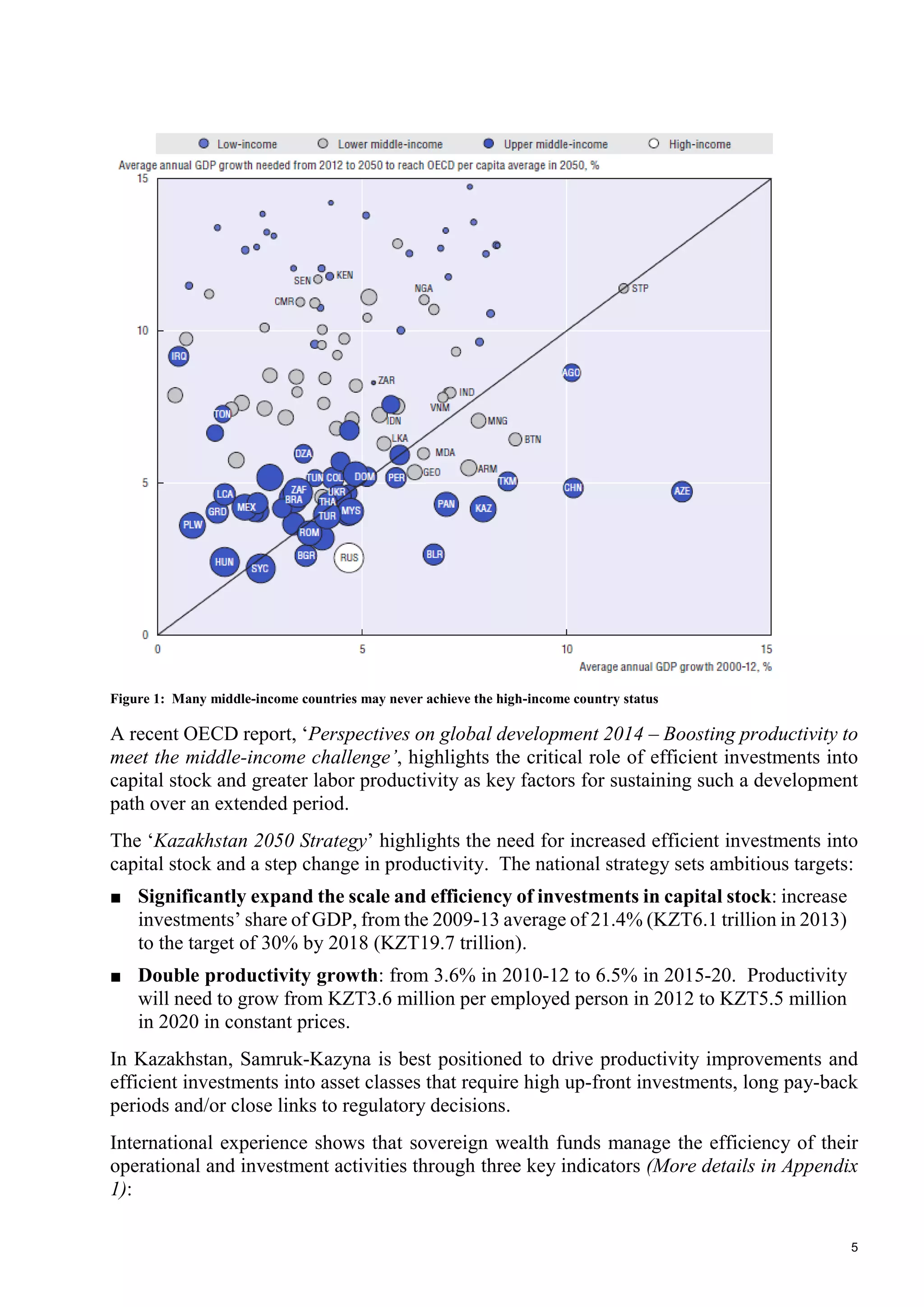
![6
1. Asset value growth. International peers have seen the market value of their assets grow
by 10-20% p.a. In 2009-2013. The Fund has demonstrated a book value growth of 7.7%
p.a. (book value is the closest proxy, since the market value of the Fund’s assets is not
available before 2013).
2. Dividend yield to shareholders. International peers with assets similar to Samruk-
Kazyna have provided up to 40% per annum of their net income as cash dividends to
shareholders (for example, Khazanah in 2009-2013). In the same period the Fund has
paid on average 13,2% of its net income (2.2% as cash dividends and 11% as other
distributions to the shareholder). In addition, the Fund and its portfolio companies
annually bear costs that may be characterized as distributions to the shareholder in the
amount of 20% of net income.
3. Value creation measured as economic profit. In 2013 the Fund was able to continue
EBITDA growth, but its economic profit was still negative. The best performing public
investors are able to generate positive economic profit. From the three strategic targets
above, the one requiring most attention is value creation measured as economic profit.
To identify the root causes for this, portfolio companies’ performance was benchmarked
against international peers. The results of this benchmarking are shown below.
In terms of the first key driver of economic profit, ‘Net Operating Profit Less Adjusted Taxes
/ Revenues’, most portfolio companies are in a satisfactory position – the Fund’s focus on
EBITDA margin has clearly driven performance improvements in recent years. However, in
terms of the second key driver, ‘Revenues / Invested Capital’, the portfolio companies clearly
lag behind their peers – the amount of capital they require to generate business is significantly
higher. This is the result of below-peer productivity, inefficient capital allocation and poor
execution of capital projects [Figure 2].
Figure 2: Benchmarking results of Portfolio companies compared to global industry peers](https://image.slidesharecdn.com/samruk-kazynatransformationprogram-170203091723/75/Transformation-program-7-2048.jpg)
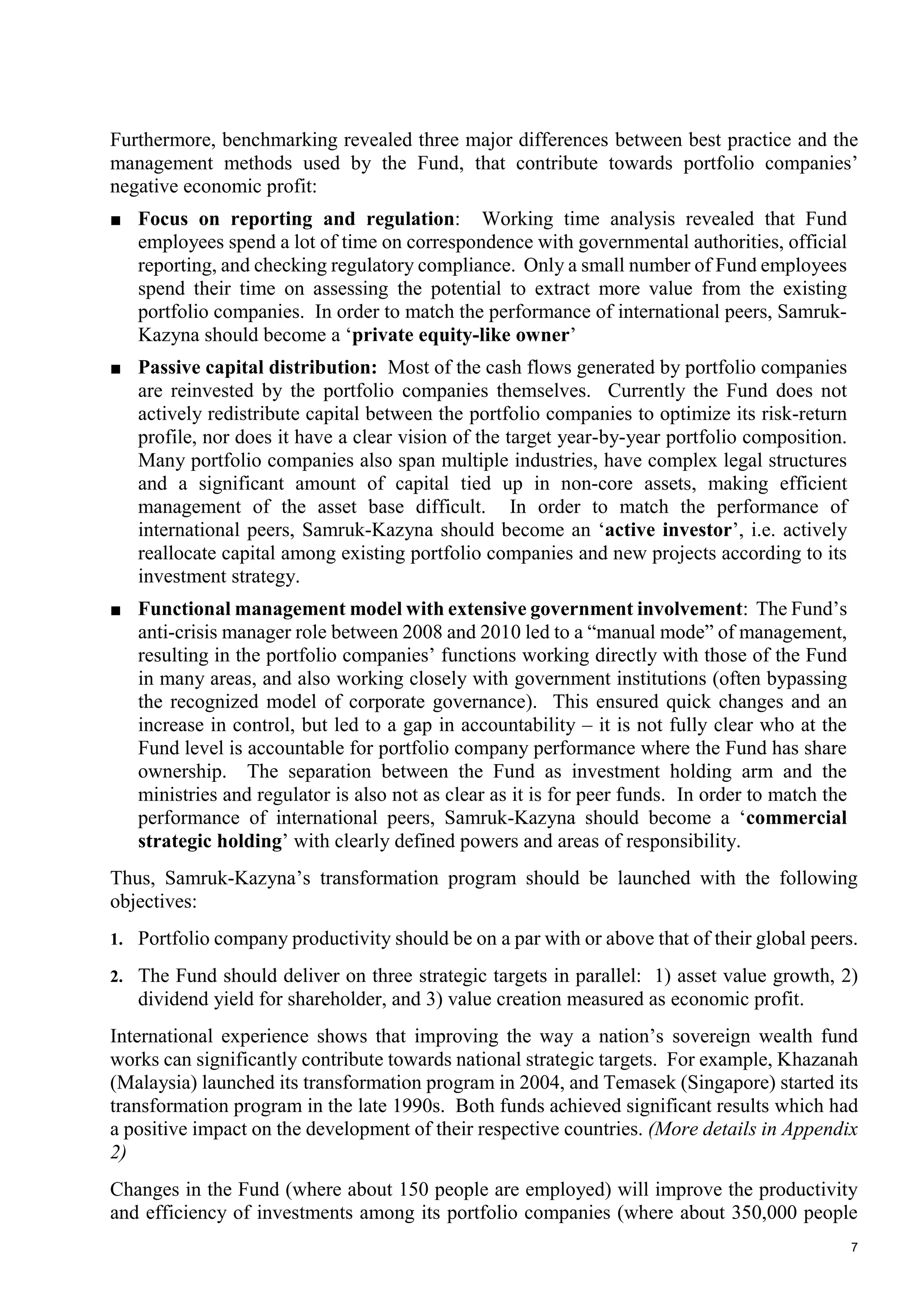
![8
are employed). Better productivity and investment efficiency among the portfolio companies
will have a positive impact across the supplier network (employing 600,000-900,000 people)
and the whole Kazakhstan business community. As a result of the transformation, Samruk-
Kazyna and its portfolio companies will thus become a talent factory for the whole country.
The objectives of the transformation described above are fully in line with the Fund’s strategy
in terms of its social responsibility to the people of Kazakhstan. Better efficiency among the
Fund’s portfolio companies will lead to better quality and competitiveness of the goods and
services they provide. This will have a positive impact on Kazakhstan’s private and corporate
consumers. Improving the Fund’s financial capacities will lead to more taxes collected from
the portfolio companies, more dividends to the government, and increased capability of the
Fund to finance strategic projects of national importance.
Table 1: Measurable targets for the Samruk-Kazyna transformation portfolio
Expected results 2019
Asset value growth
[KZT; % increase in book value]
630-
1 000 bn
8-12%
Recorded dividend yield for shareholder
[KZT; % of net income]
190 bn
20%
Value creation measured as economic profit
Break-even in EVA terms (for
12 largest companies) by 2020
Portfolio companies performing at par or above the
global industry peers in productivity (based on three
above indicators)
8/8
2. ACTIONS ON WHICH THE TRANSFORMATION WILL FOCUS
Key messages of this chapter:
■ Samruk-Kazyna’s transformation program includes 9 initiatives across three
axes of transformation: 1) value improvement in portfolio companies, 2)
portfolio restructuring and changing the Fund’s approach to investing, 3)
reforming powers and responsibilities in the Fund’s and portfolio companies’
governance
■ The transformation will deliver its intended results only if all improvement
areas are successfully implemented in both the Fund and the portfolio
companies](https://image.slidesharecdn.com/samruk-kazynatransformationprogram-170203091723/75/Transformation-program-9-2048.jpg)
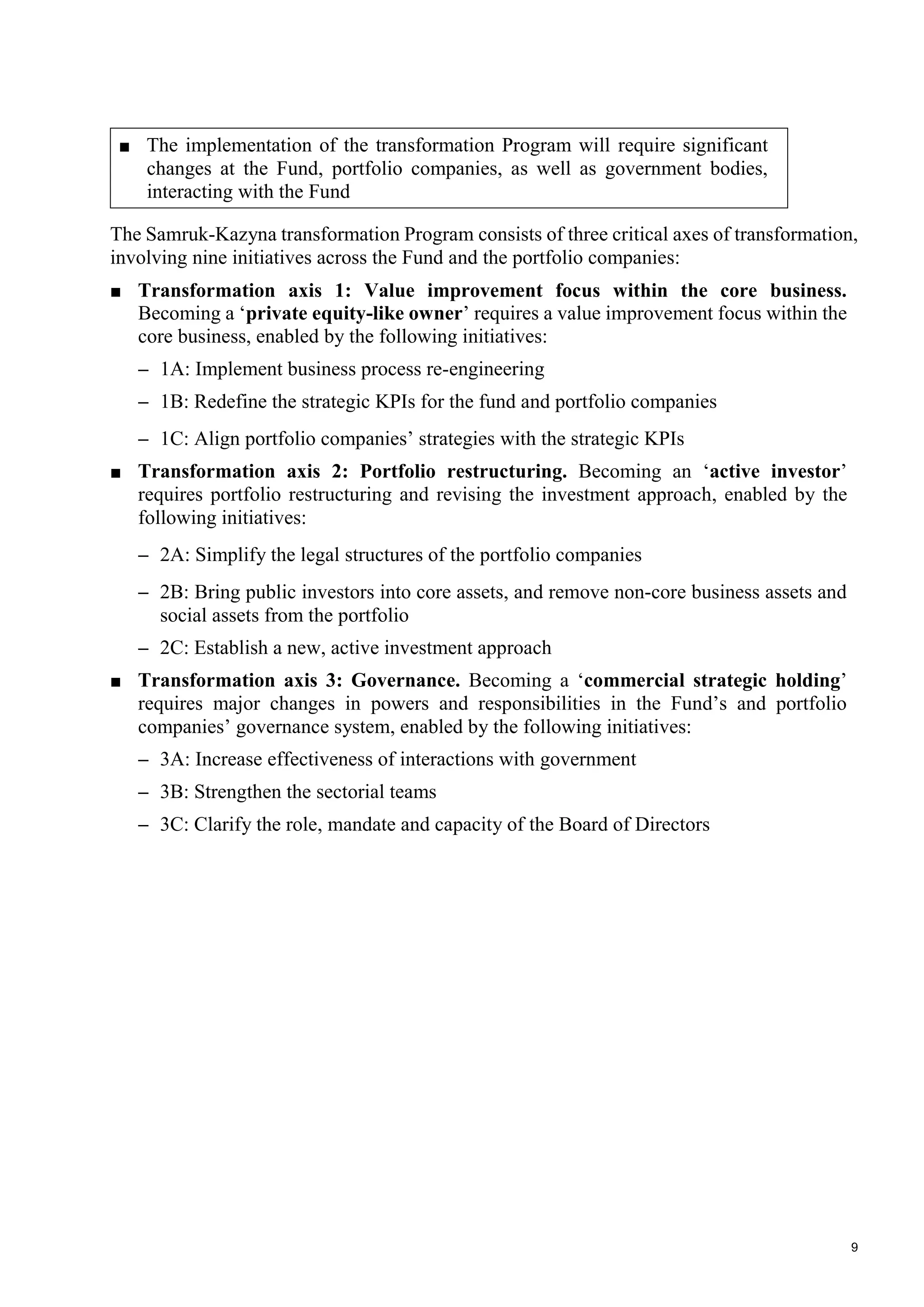
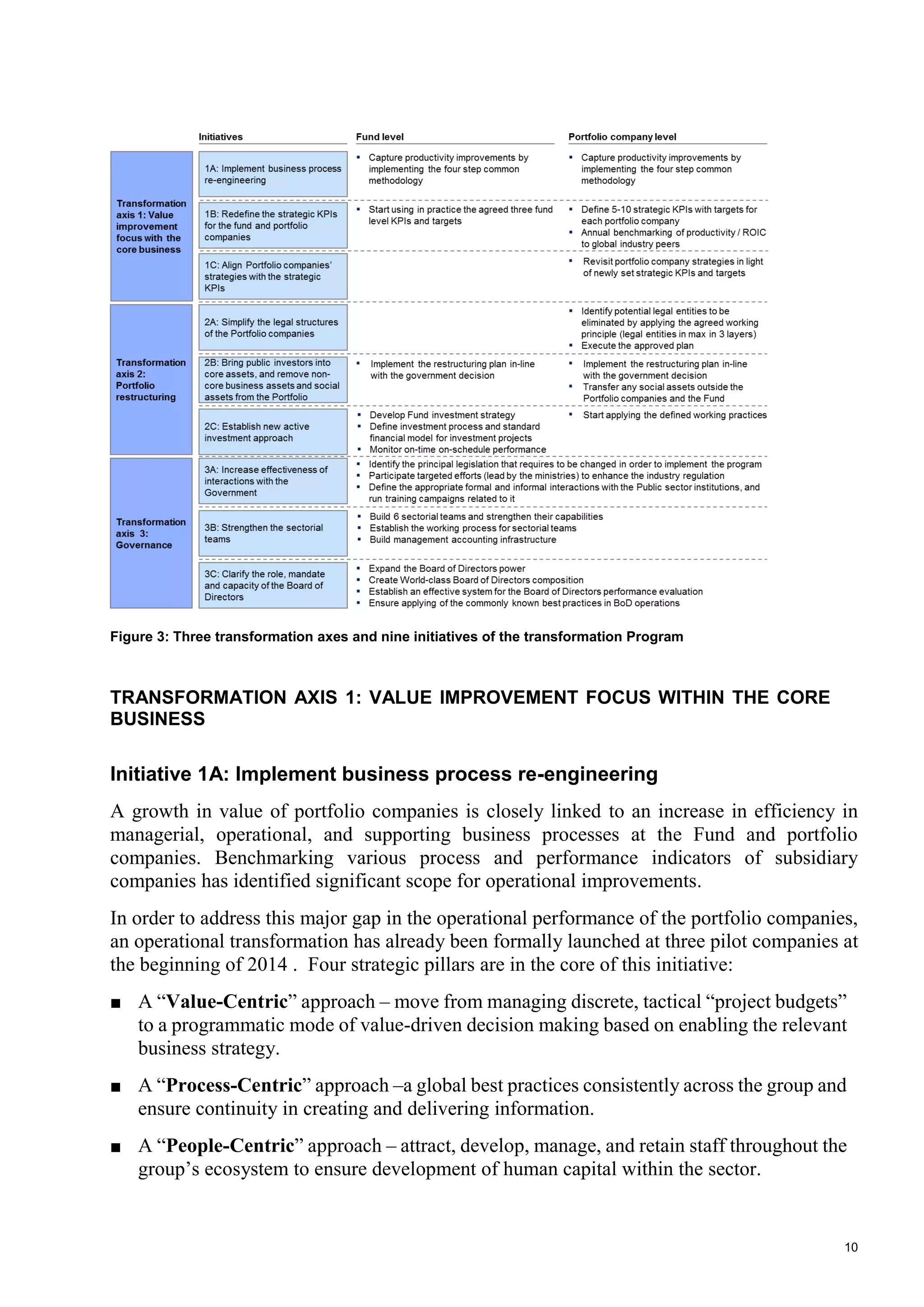
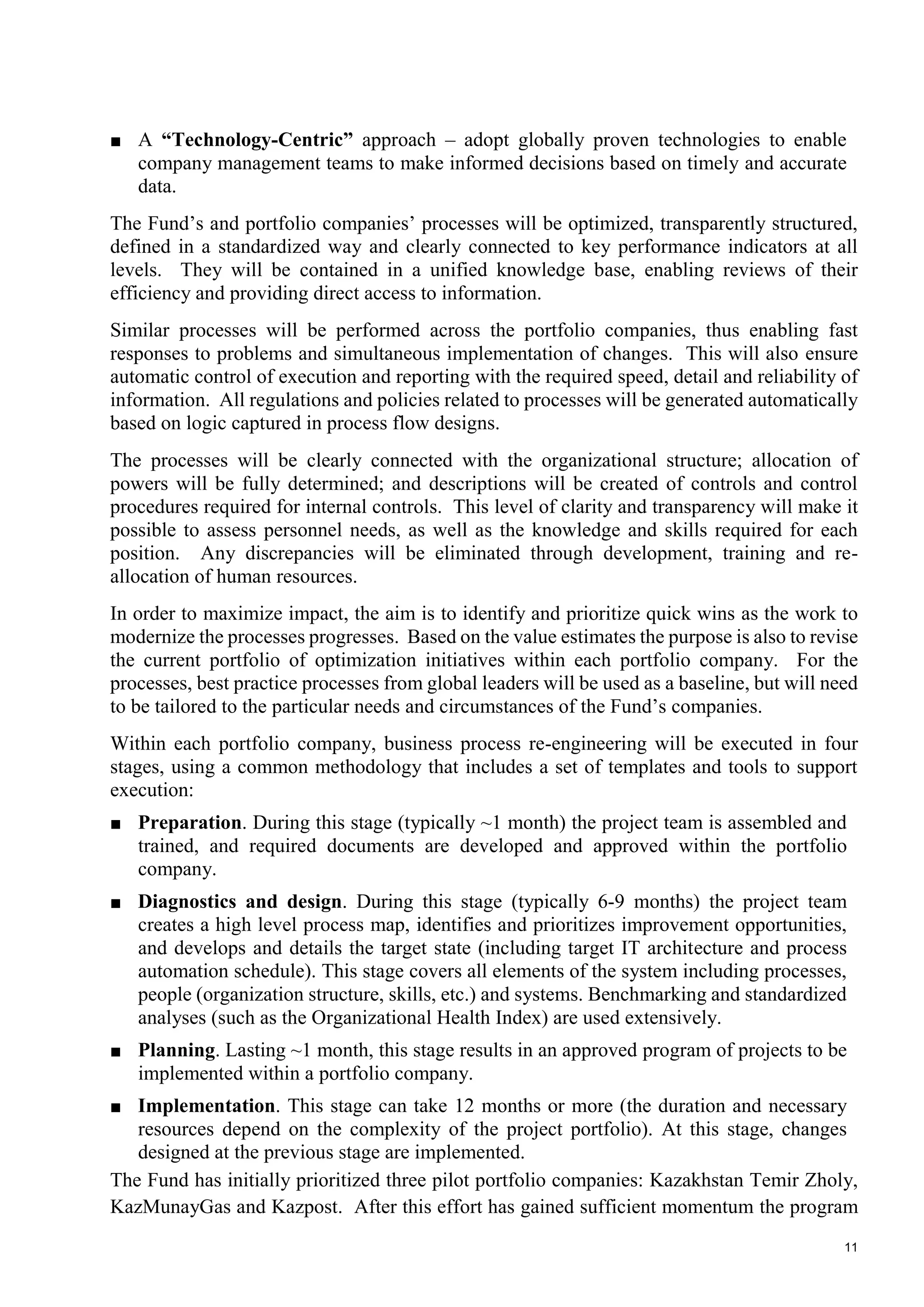
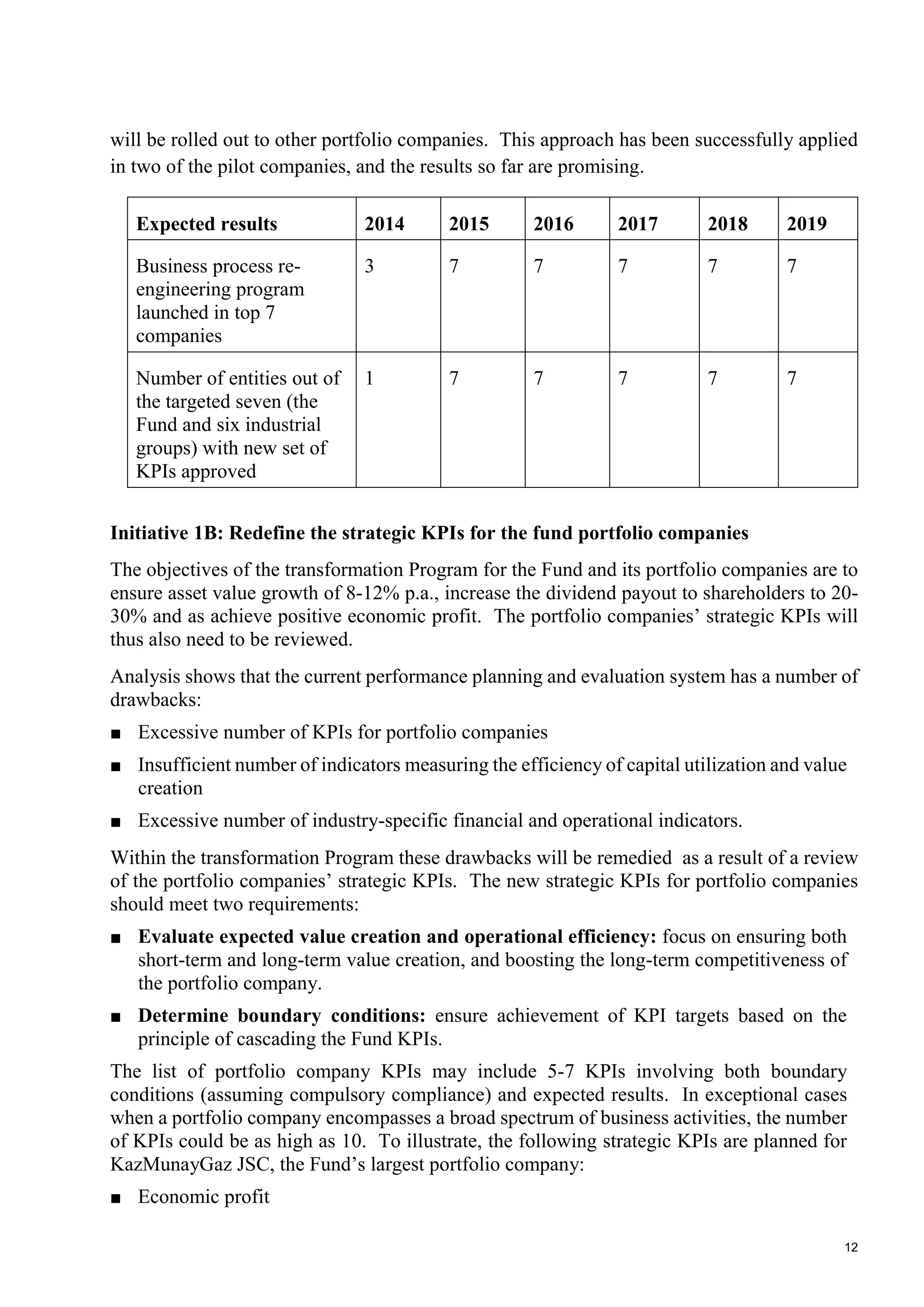


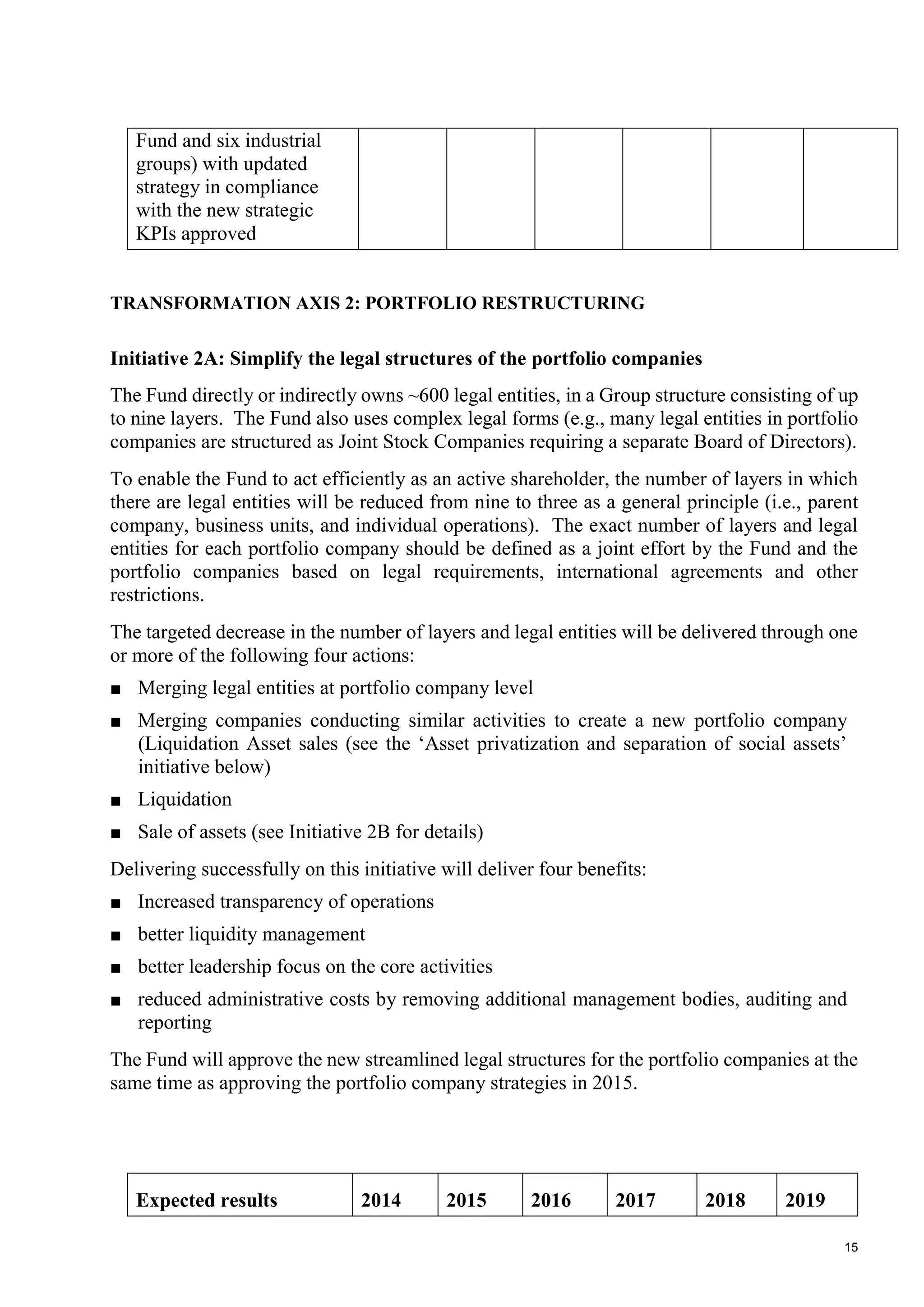
![16
Number of legal entities
across portfolio
companies
593 500 400 300 300 300
The number of layers
with legal entities (incl.
the Fund)
9 8 8 5 5 5
Initiative 2B: Attracting foreign investors and disposal of non-core assets from the
Fund’s portfolio
Less than 30% of the Fund’s group of companies’ base is currently listed, significantly less
than is the case with comparable international peers. Limited equity participation by private
investors does not promote external market discipline in portfolio company operations, and
makes it unfeasible to use market value as the basis for objective evaluation of portfolio
company performance. Most portfolio companies also include assets of varying profiles: core
business activities, non-core assets, and socially oriented assets. [Figure 4]
Figure 4: Mapping of portfolio companies assets across industries
The Government of the Republic of Kazakhstan under the instruction of the Head of State approved
the Complex Privatization Plan according to which 216 Fund’s assets are subject to be transferred to
the competitive environment in 2016-2020. 44 assets from attachment No.3 are expected to realize
with the assistance of independent consultants. 172 assets from attachment No.4 are planned to
dispose through electronic auction. In relation to the Fund the privatization program can help to solve
the following problems:
■ Exposing core assets to external market discipline to drive value creation
Overlap of sectors in different portfolio companies Investments of the parent company as of 2012, Bln tenge
Oil and gas
exploration
Electricity
generation
Metallurgy
Heavy machinery
Equipment
manufacturing
Physical
protection
Mining
Electricity
transmission
Logistics services
Core activity
Airports:
Pavlodar,
Aktobe,Atyrau
Telecom
Logistics
infrastructure
Mangustai-
electromunai
Ship repairing
plant of Man-
gistau region
Munaitelecom
Eurasia Air
Batumi sea
port
Semser
security
Core activity
MAEK
Uranenergo
Kazsilicon
Mashzavod,
EcoEnergo-
Mash
Ulba transport
Ulba transport
Zhanakorgan
transit
Korgan-
Kazatomprom
Mangashlyk-
Munai
Forum Muider
B.V.
Core activity
Alatau Zharyk
Company
Core activity
M3 security
Locomotive
kurastyry zauty
Core activityTranstelecom
Military
railway
security
KTZ express
Airports Asta-
na, Petropav-
lovsk,Kostanai
Core activity
Core activity
Declared
plans
Core activity
Core activity
8.9
41.7
64.8
1.3
11.5
5.8
0.2
88.7
7.3
113
7.8
8.7
Aktubinsk rail
and structural
steel plant 1.7
9.4
9.9
12.8
4.9
4.7
265](https://image.slidesharecdn.com/samruk-kazynatransformationprogram-170203091723/75/Transformation-program-17-2048.jpg)
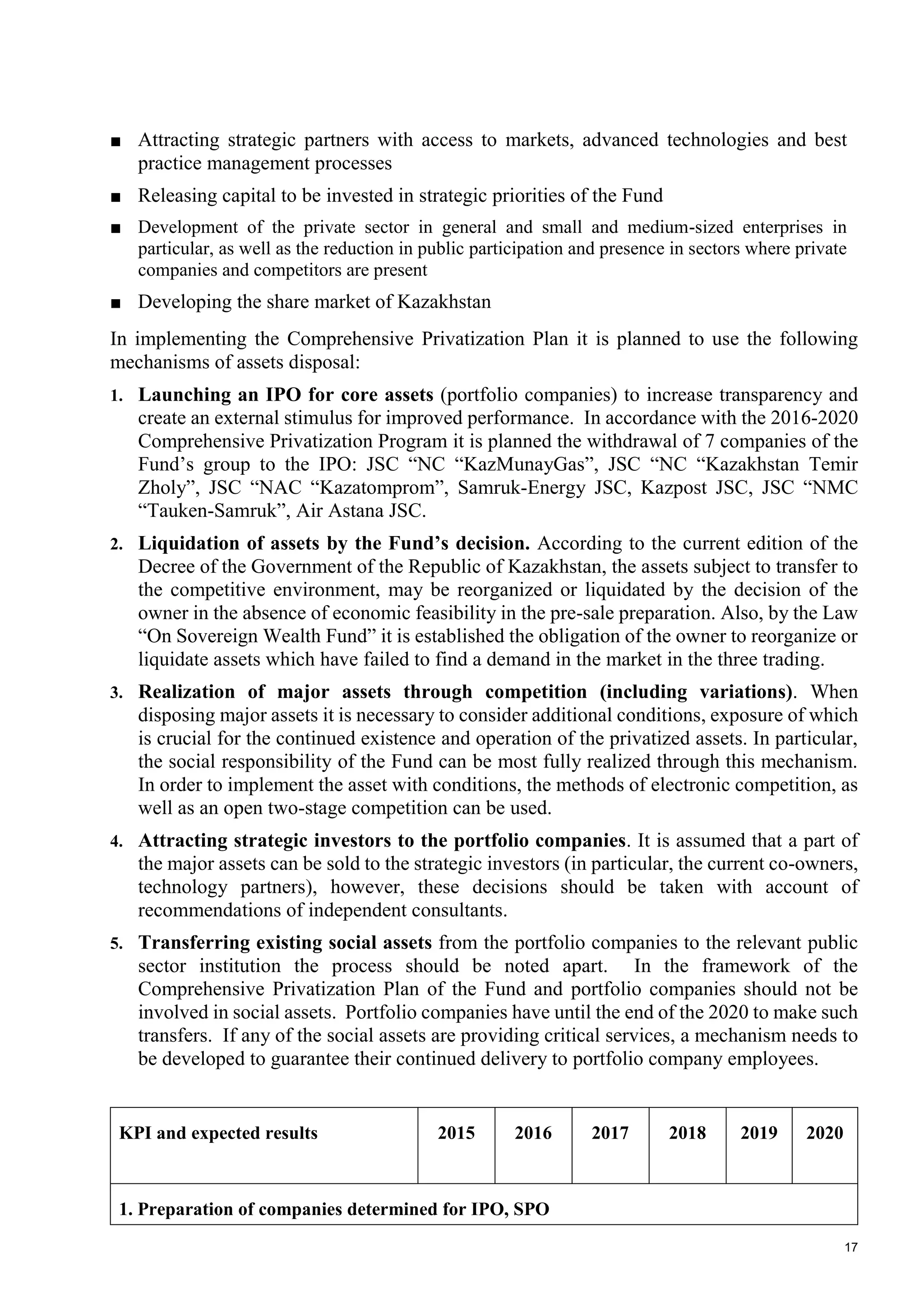
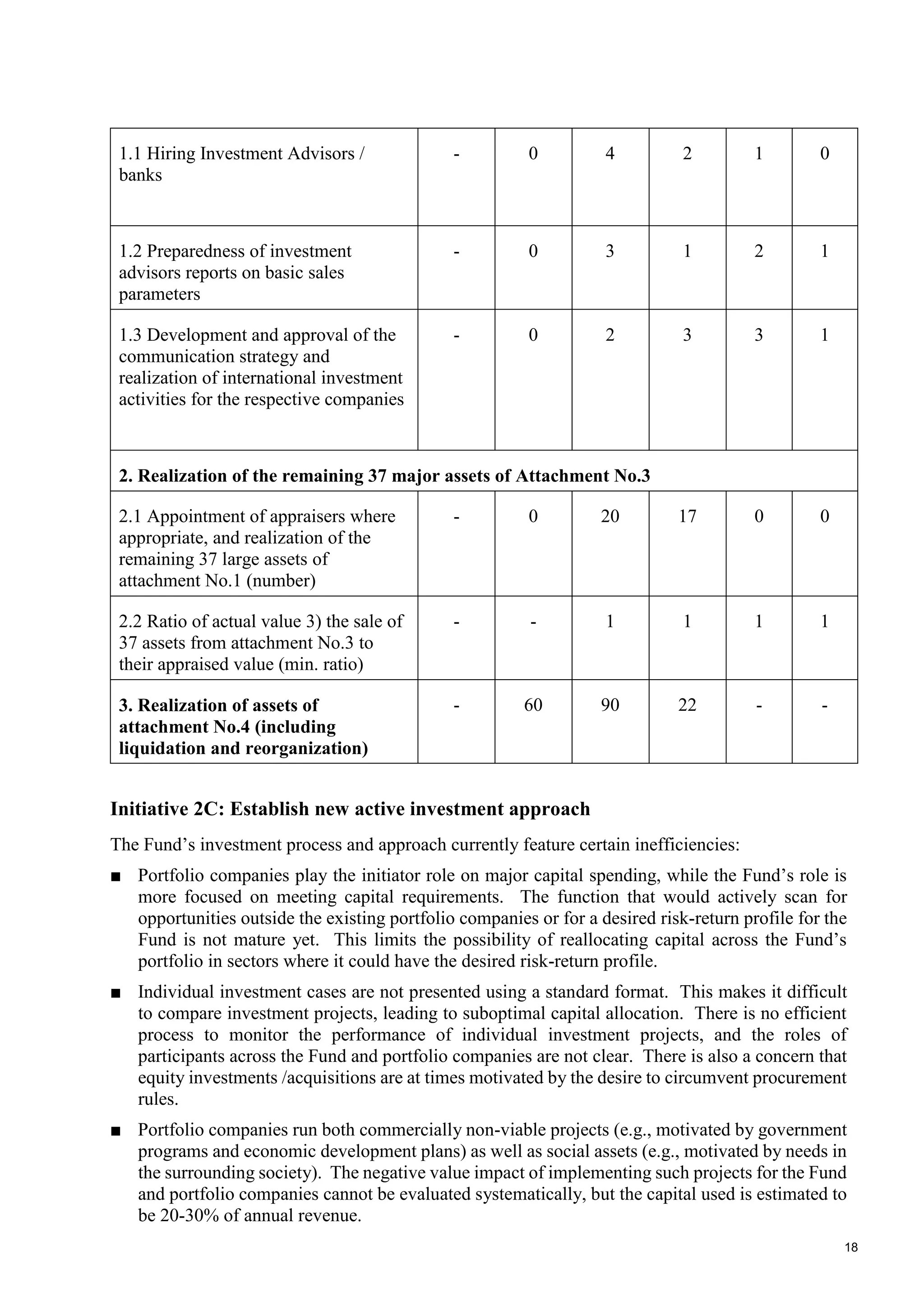
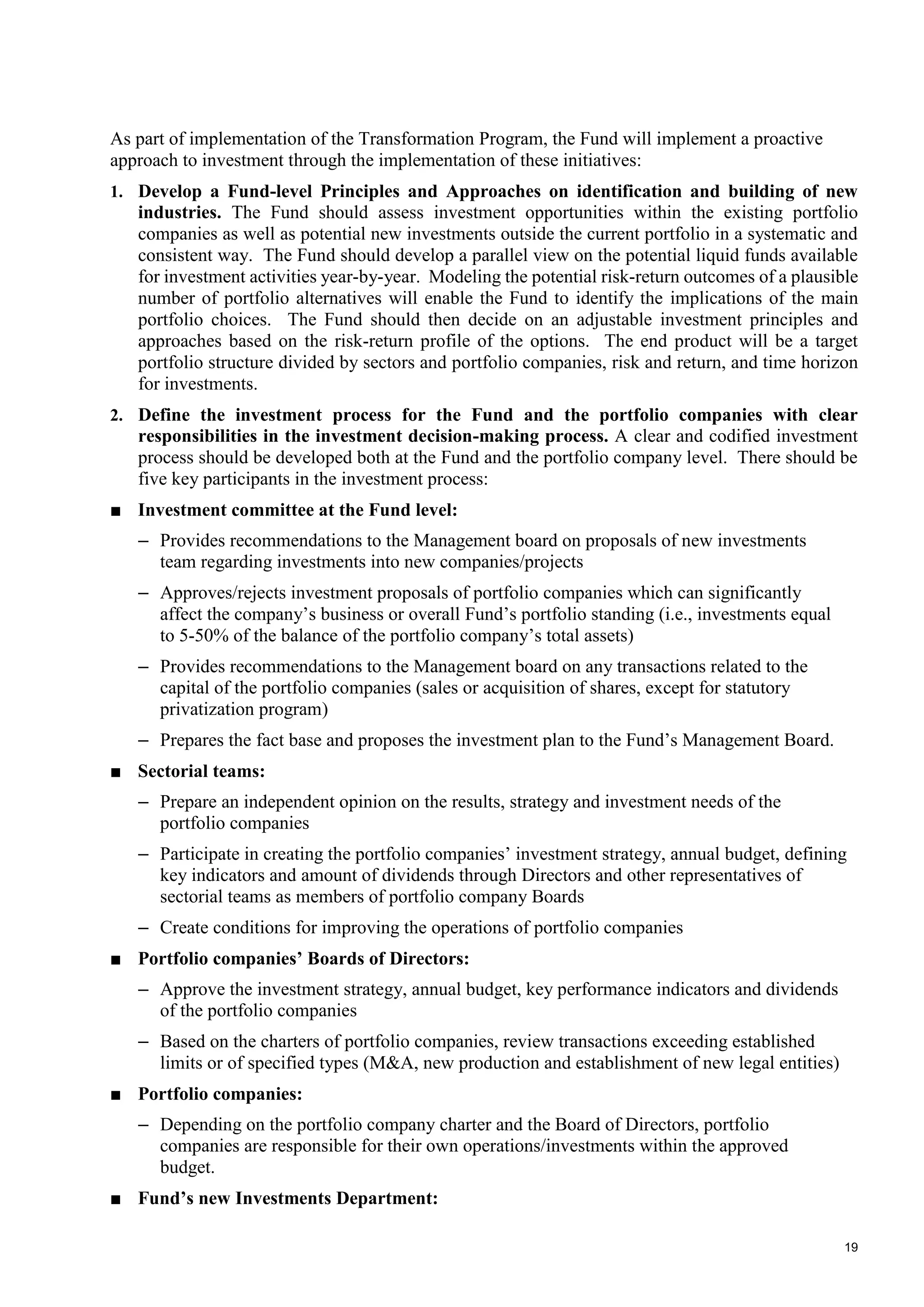
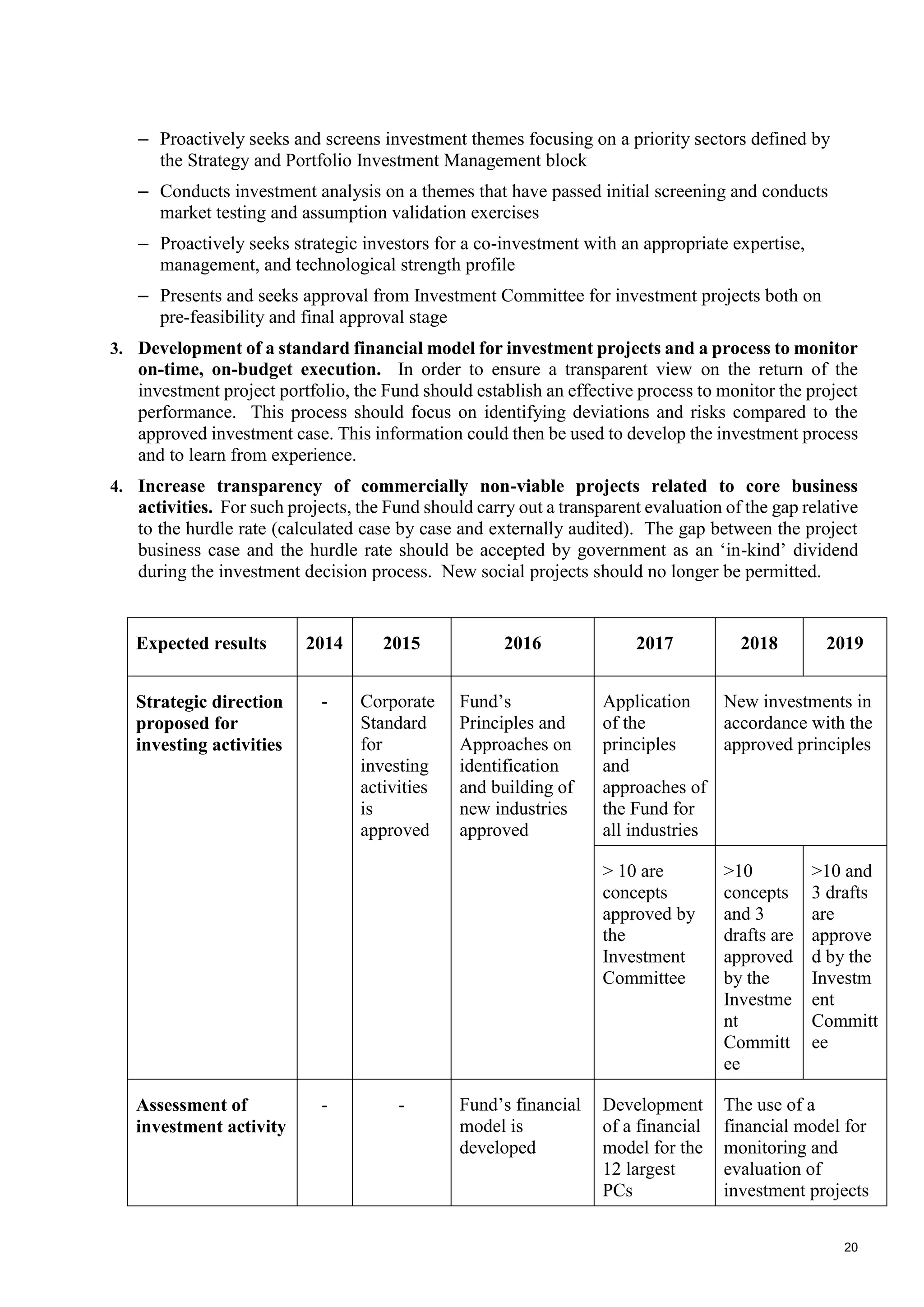
![21
Development
of criteria for
the approval
of new
investment
projects
The use
of
investme
nt
criteria
and
standards
in
investing
activities
Improvi
ng
criteria
Monitoring of
investment activity
- - - Creating a
database of
investment
projects and
monitoring
reports
Development
of criteria for
stopping
unprofitable
projects
TRANSFORMATION AXIS 3: GOVERNANCE
Initiative 3A: Increase effectiveness of interactions with government
The current governance allows the participation of government authorities in operating and
investment decision-making at the Fund level and portfolio companies. This practice could
change commercial logic in decision-making and contradicts governance practice in effective
international Funds, that is focused on maximizing portfolio value. Decreasing government
influence and formalizing government’s involvement in operation and investment decision-
making is one of the key priorities of the transformation program.
Furthermore, where portfolio companies are subject to regulation in natural monopolies or
other markets, their performance is strongly affected by their interactions with regulators.
Comparative analysis of such interactions and assessment of best-practice government tariff
regulation has shown that there is significant potential for improvement in regulation in
specific industries (for example, in process of tariff costs confirmation, divergence from tariff
methodology based on “costs+”).
International sovereign wealth funds operate better in more effective government regulation
frameworks and with a lesser degree of government influence in their operations.[Figure 5]](https://image.slidesharecdn.com/samruk-kazynatransformationprogram-170203091723/75/Transformation-program-22-2048.jpg)
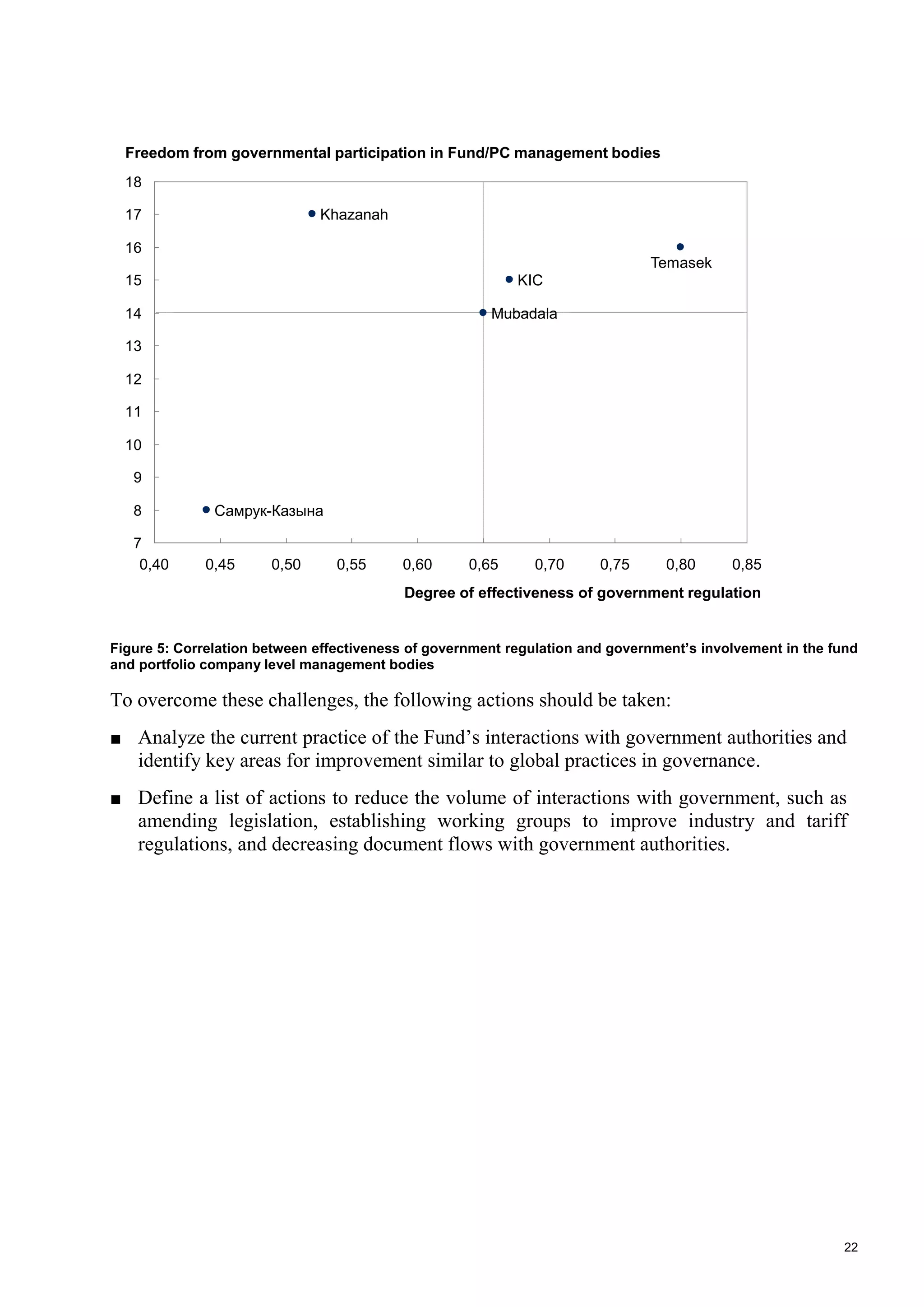
![23
Expected results 2014 2015 2016 2017 2018 2019
Creation of GR-function in
the Fund and Portfolio
companies [Companies
quantity]
0 0 1 7 7 7
Reducing the correspondence
rate from the Government to
the Fund and its companies
and requiring meaningful
response vs. base line year
2014 [%]
0% 30% 50% 50% 60% 70%
Initiative 3B: Strengthen Sectorial teams
Currently the Fund has three sectorial teams. Their headcount is 30 FTEs, which accounts
for 20% of the total FTEs of the Fund. In global peer organizations the employees located in
sectorial teams account for 60% of the total FTEs. 67% of the sectorial team employees
currently have a purely technical background, 97% have industrial experience only in
Kazakhstan based companies and 41% have governmental service experience. Only 23% are
fluent in a foreign language, and one third meet the competence level in managerial skills
typically seen as a requirement by the Fund’s international peers.
Furthermore, nobody in the sectorial teams has experience of managing successful
international companies in the global market context, conducting high quality business
analysis or identifying at a granular level the value creation opportunities with the portfolio
companies. There are no sectorial team members with a business degree (e.g., MBA) or
people with internationally recognized relevant certification (e.g., ACCA or PMA). The
current set of competences within the sectorial teams enables the Fund to play its current role
focused on reporting and regulation, but prevents it from acting as a fully commercial strategic
holding / active strategic investor.
In successful peer funds at least 75% of the work of the sectorial teams is focused on value
creation, with the remainder including activities such as interaction with the regulatory
authorities and other tasks. Toda, 60% of the Fund’s employees’ time is spent on regulatory
correspondence with the government. To improve the quality of managing the portfolio
companies the Fund should transform the sectorial teams’ activities and focus them on
strategic assessments, investments and economic analysis. The sectorial teams’ senior leaders
should represent the Fund on portfolio companies’ boards of directors with a strong focus on
driving productivity and efficient investments.
As well as analyzing portfolio companies’ operational efficiency and efficiency of
investments, the sectorial teams’ responsibilities should cover:
■ Determining strategic development areas and long-term goals for the portfolio
companies taking into consideration the sector specific global development trends](https://image.slidesharecdn.com/samruk-kazynatransformationprogram-170203091723/75/Transformation-program-24-2048.jpg)

![25
Expected results 2014 2015 2016 2017 2018 2019
Relative share of
‘Commercial block’ of the
total Fund staff
[% of headcount
employees]
n/a n/a 55% 60% 60% 60%
‘Commercial block’
positions filled in with
target capability level
[%]
- - 50% 100% 100% 100%
Initiative 3C: Clarify the role, mandate and capacity of Boards of Directors
Boards of Directors currently lack sufficient mandate, independence, skills, experience and
authority to collaborate with and oversee portfolio company CEOs. Boards also do not have
the full powers they should, including selection, appointment and dismissal of CEOs.
Within the Program, the role and responsibility of Boards of Directors is recognized as a
critical enabler for transformation. Over the next two years the Fund will change the corporate
governance model by putting in place highly skilled Boards of Directors with the full set of
required competencies, powers, expertise and skills, as well as relevant responsibility. The
following tasks will be implemented for this purpose:
1. Expand the powers of Boards: Provide Boards of Directors with a complete set of
decision making rights and relevant responsibility for the portfolio companies’
performance. Strengthen the role of the Chairman and give the BoD the right to appoint
and dismiss the CEO and define compensation levels for the management board and
employees. Determine the main areas for the BoD to work on by setting clear
expectations through the new strategic KPIs.
2. Create world class Boards: Increase the number of Board members to 7-11 persons
and lay down the main requirements for new directors, e.g., global CEO level industry
expertise, functional knowledge associated with strategic initiatives and at least one
director having experience in an international audit company at the level of partner or
higher. The proportion of independent directors should be also increased to 50% or
more. The Fund’s role in the BoD should be also strengthened: the head of the sectorial
team should be Chairman of the portfolio company Board of Directors and members of
the sectorial teams (Director and two Vice Presidents) should also sit on the BoD.
3. Establish an effective system for Board performance evaluation. The BoD itself, led
by the Chairman, should perform a proper assessment of its results and efficiency. The
shareholders should also evaluate the performance of the BoD (independently or
involving an independent advisor) in line with the procedure established by the Fund.
Areas for performance improvement across the Board or for certain directors should be
defined accordingly.](https://image.slidesharecdn.com/samruk-kazynatransformationprogram-170203091723/75/Transformation-program-26-2048.jpg)

![27
Approval of new Methodology on
diagnostics of Corporate
Governance system by the
Management Board of the Fund
Compl
eted
Approval of new Methodology on diagnostics of Corporate Governance system by the
Management Board of the Fund:
Agree on criteria and set the
targets
Compl
eted
Run assessment 0 0 0 6 6 6
Number of companies out of the
targeted six industrial groups with
Board of Directors appointed in-
line with the requirements of the
new Corporate Governance Code
[Number of portfolio companies
out of the targeted six industrial
groups]
0 1 4 6 6 6](https://image.slidesharecdn.com/samruk-kazynatransformationprogram-170203091723/75/Transformation-program-28-2048.jpg)

![29
alignment through seminars, off-sites, working meetings, and visits to other funds to learn
about successful transformation programs.
As described in the previous section, accountability for each transformation initiative will be
allocated to individual line managers (from the Fund, from portfolio companies, or both). The
approach is to use the same four change management levers across the three axes. This will
instil a common change management approach across the Fund and the portfolio companies
and enable the deployment of Fund-level change management experts to support the portfolio
companies, ensure knowledge sharing, and allow efficient use of limited resources to achieve
success.
The role of the Fund-level change management experts will be to support each portfolio
company – at the right time and by request – with guidance and practical change management
tools. The change management expert team will be formed in Q4 2014 and is expected to
ramp up to 5-10 employees as the portfolio companies start transforming.
The four levers needed to drive behavior and mindset changes are described in the ‘influence
model’ developed through McKinsey & Company research over many years [Figure 6]. The
model includes both ‘traditional’ change management elements to engage people, skill
building to drive a new level of performance; as well as methodologies to redraw
organisational structures and codify the new ways of working.
Figure 6: Influence model with four change management levers
Change management lever 4: Building the required skills
Employees must be confident in their ability to behave in the way the new operating model
requires. This can be achieved through training, coaching, on the job development and
rotations (usually a combination of these). Currently the majority of skill-building efforts are
class-room training and almost exclusively focused on technical skills. In light of the skills
required in the future, this approach left gaps in leadership, establishment of efficient teams,](https://image.slidesharecdn.com/samruk-kazynatransformationprogram-170203091723/75/Transformation-program-30-2048.jpg)
![30
strategic thinking and project management. Research shows transformations that invest a
great deal in developing leaders are two-and-a-half times more likely to succeed than those
that do not. Initiatives here would include:
■ Employee assessment based on the Leadership Competency Model laying out the
behavioral foundation needed by Fund employees, to result in individual development
plans, recruiting methods, etc.
■ Change leadership workshops (‘Change Leaders Forums’) for senior managers: a
rigorous approach to build change skills across management teams in each department,
e.g., through proven two-day workshops resulting in a detailed action plan; regular
check-ins; subsequent two-day workshops to review progress and further build change
leadership skills 6-12 months later
■ Conference/team building for top teams of the Fund and portfolio companies – a
one-off event to visibly kick off the transformation
■ Attracting new talent by establishing a strong employer brand that appeals to the
best and brightest Kazakh talents at all levels, not only through salary and benefits
offered, but also through corporate values, inspiring leaders and interesting job content.
Compensation benchmarking should be the first step to ensure competitiveness
■ Managerial and technical skills developed through corporate learning, including the
Samruk-Kazyna Corporate University. The University will be strengthened to
incorporate world-class elements, as described in [Figure 7]. Among the first enhanced
offerings will be:
– Leadership development program for the top 200 senior managers to quickly fill the
leadership pipeline
– Core trainings for managers (e.g., situational leadership, establishment of efficient
teams, strategic thinking and project management, ownership of own development,
mentoring and coaching, feedback), developed and implemented throughout 2014-15
– E-learning Portal providing self-development resources and materials for employees
to access at their own pace online](https://image.slidesharecdn.com/samruk-kazynatransformationprogram-170203091723/75/Transformation-program-31-2048.jpg)
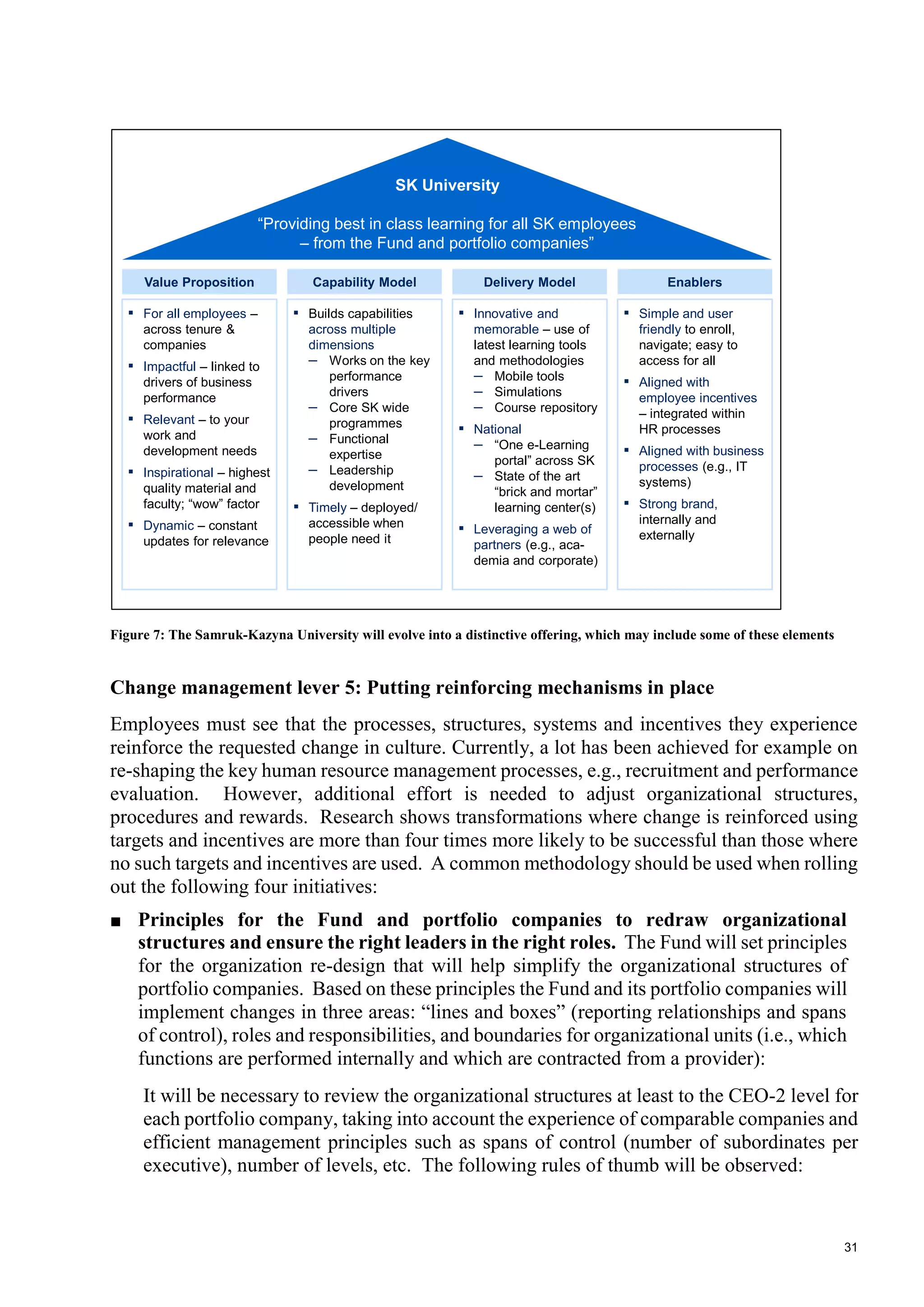
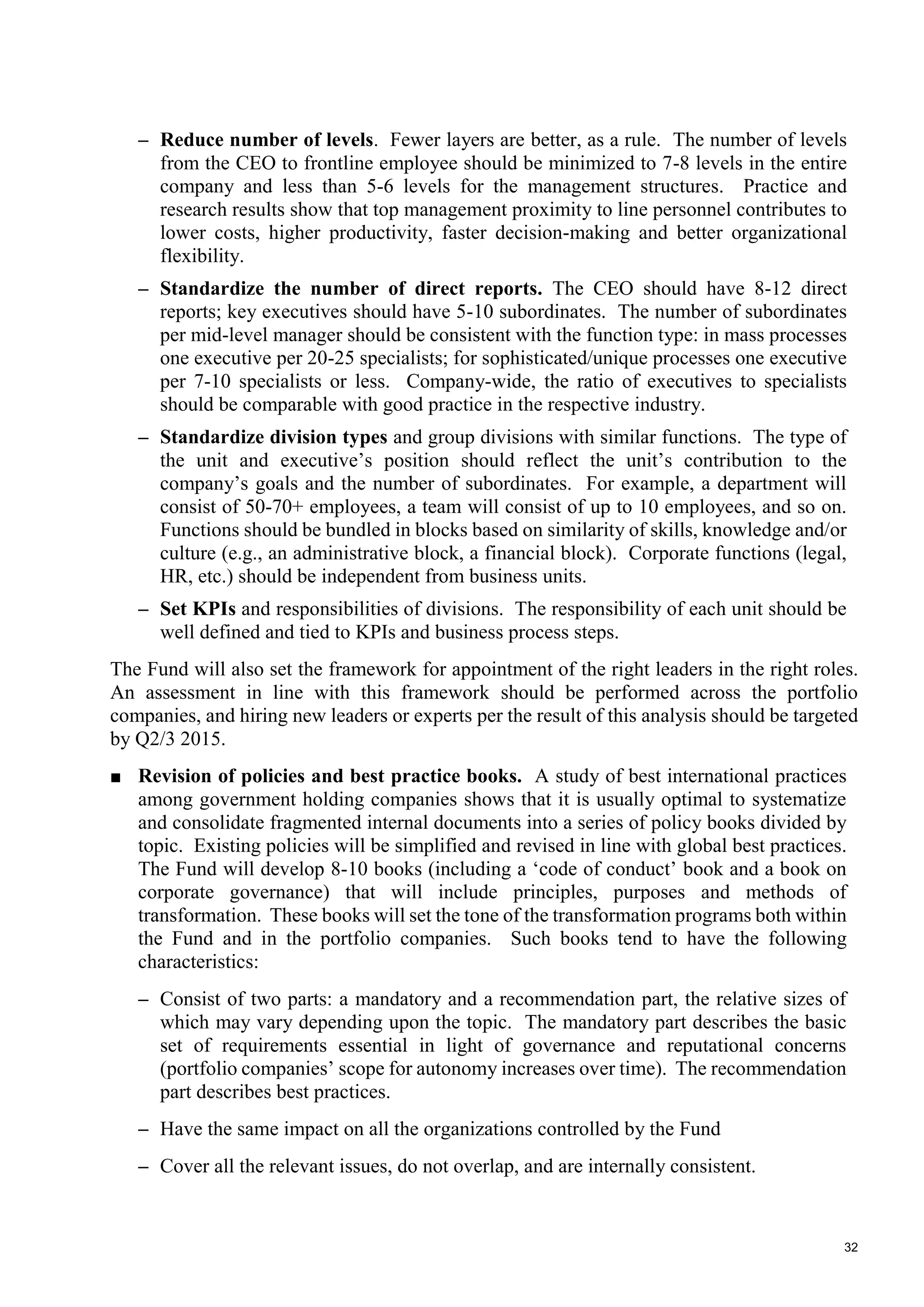
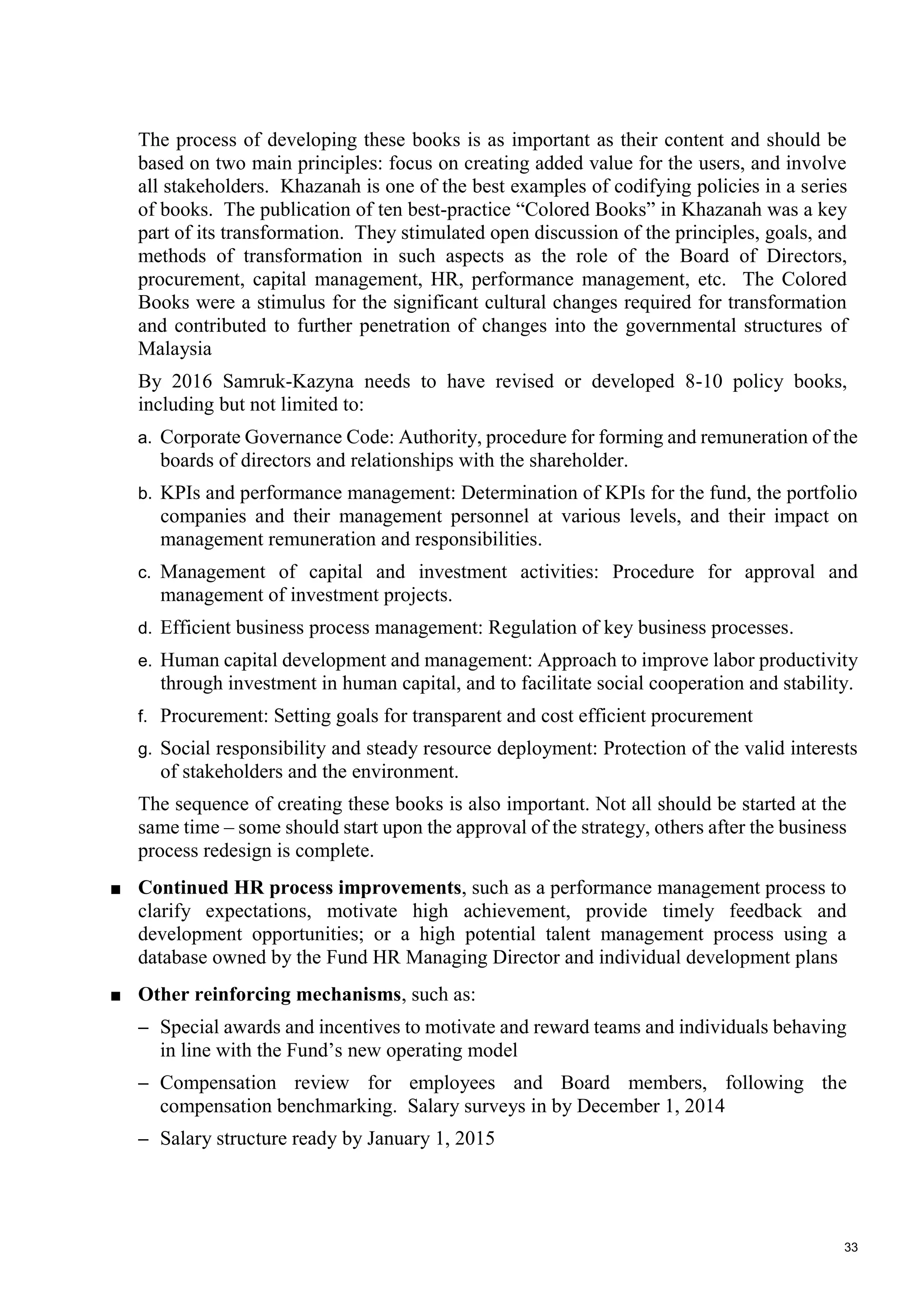
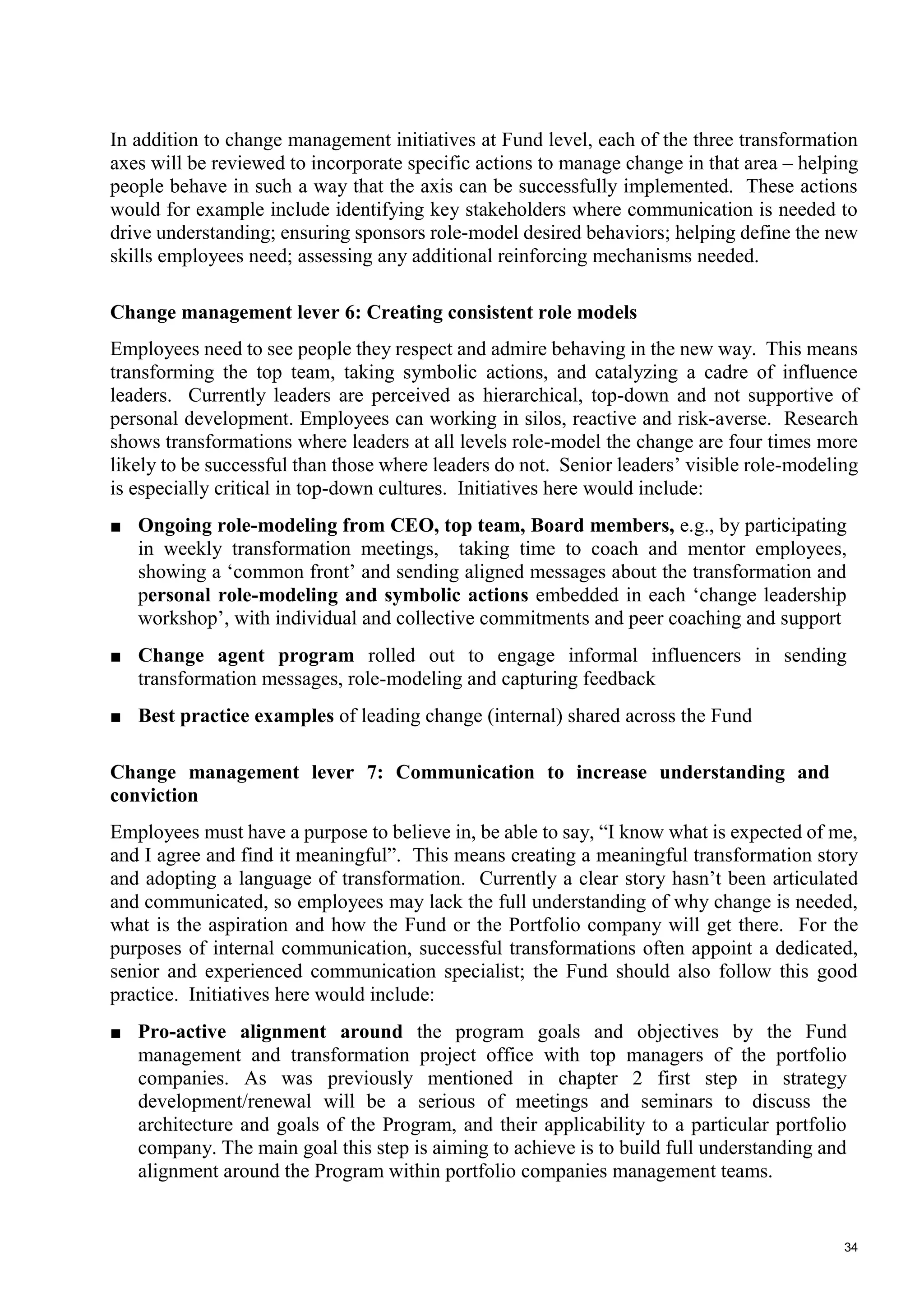
![35
■ Transformation story for the Fund, first articulated by the CEO. Research shows
transformations with a compelling “story” are almost four times more likely to be
successful than those without. The transformation story is a narrative that lays out in
direct language, personal to the sender, why change is needed, what needs to change,
how the transformation will be achieved, the leader’s commitments and expectations
from his/ her reports. This should be followed by the cascade of the transformation
story, from CEO to direct reports and so on deeper into the organization (Deadline: Oct-
Dec 2014). Given the strong relationships between managers and direct reports, the
cascade amplifies the key messages in the CEO’s transformation story. Messages should
be delivered verbally and reinforced over time
■ Comprehensive two-way communications plan including town-hall meetings,
newsletters, blogs, etc., giving Fund employees the opportunity to ask questions,
communicate concerns, suggest ideas and be heard
■ Pulse survey to ensure two-way communication during the transformation, polling
groups of Fund employees on how they view the most critical mindset and behavior
shifts
■ External communication/ public relations, to establish proper positioning of the
program and proactively align the external stakeholders and public opinion. Given the
Fund’s eminent role in Kazakhstani society, external stakeholders will have a major
impact on how internal Fund and portfolio company stakeholders transform
Initiative KPI and expected
results
2014 2015 2016 2017 2018 2019
People transformation
Implementation of the
principles of a
meritocracy through
Job Matching
The number of
companies with
completed job
matching in the
transition to the new
organizational structure
(CEO-1, key positions
of CEO-2 upon
decision of companies)
0 0 5 12
Implementation of the
principles of a
meritocracy through
target HR processes
[The number of
implemented target
processes in 12 PCs]
Implemented
processes: search and
selection, performance
assessment,
remuneration
management are
implemented
7 12
Implemented
processes: learning and
development, talent
2 7 12](https://image.slidesharecdn.com/samruk-kazynatransformationprogram-170203091723/75/Transformation-program-36-2048.jpg)

![37
■ Major initiatives of the Transformation program described in this document are
expected to last until the end of 2017. Overall program is long-term and is
expected to last over 5 years
The transformation includes the description of activities, their timeline, and responsible
individuals to deliver the goals of the transformation. These activities will be detailed further
into more specific steps, after initiative teams are formed. The roadmap covers both initiatives
(the “what” has to change part of the transformation) as well as change management (the
“how” of the transformation). This roadmap is starting from the basis that the already done
work on business process re-engineering has created. It spans a four year period until the end
of 2018 and is divided into three stages [Figure 8]:
5. Preliminary stage: Final preparation stage at Fund level, continuing with the pilot portfolio
companies (Q4 2014 – Q1 2015)
6. Full rollout: Changes at the Fund level and peak at pilot portfolio companies (2015)
7. First results of transformation (2015-16 onwards).
Overview of stages in roadmap is shown below.
Figure 8: Three stages of the transformation
Transformation initiatives roadmap
During preliminary stage the project governance and infrastructure will be adjusted to the new
expanded scope and complexity. This includes recruiting the additional people to the Samruk-
Kazyna transformation PMO and appointing responsible for each initiative. Other critical
activities at this time will include approving a list of KPIs at the Fund level. The portfolio
companies’ legal structure will be also reviewed and the action plan for its simplification will
be developed; non-core and social assets will be identified for subsequent disposal. Also in](https://image.slidesharecdn.com/samruk-kazynatransformationprogram-170203091723/75/Transformation-program-38-2048.jpg)
![38
late 2014 the review and approval process will begin for the legislative amendments that are
necessary for the transformation to be successful.
Beginning in 2015 the larger changes at the Fund level starts showing as well as in the three
selected pilot portfolio companies (KMG, KTZh, KazPost): development a new Fund’s
investment strategy and new employees will gradually be hired in sectorial teams who will
be one of the key elements in success of the transformation program. At the same time,
changes will be made in the powers and composition of the Boards of Directors with a view
making them closer to best practices. At the Fund and in portfolio companies, the new KPIs
and their targets will be approved, which will result in new strategies being developed for
these companies. The implementation of new business processes based on best global
practices starts in H2 2015 with a projected completion being in 2016. The disposal of non-
core and social assets will start in mid-2016 to be completed by the end of 2017.
In 2016 the transformation process will encompass all the portfolio companies. Most activities
within the Group are expected to be completed by the end of 2016. Disposal of non-core and
social assets, business process reengineering in the wave 2 portfolio companies, and the IPOs
of core assets. are expected to be over by the end of 2018. [Figure 9]](https://image.slidesharecdn.com/samruk-kazynatransformationprogram-170203091723/75/Transformation-program-39-2048.jpg)
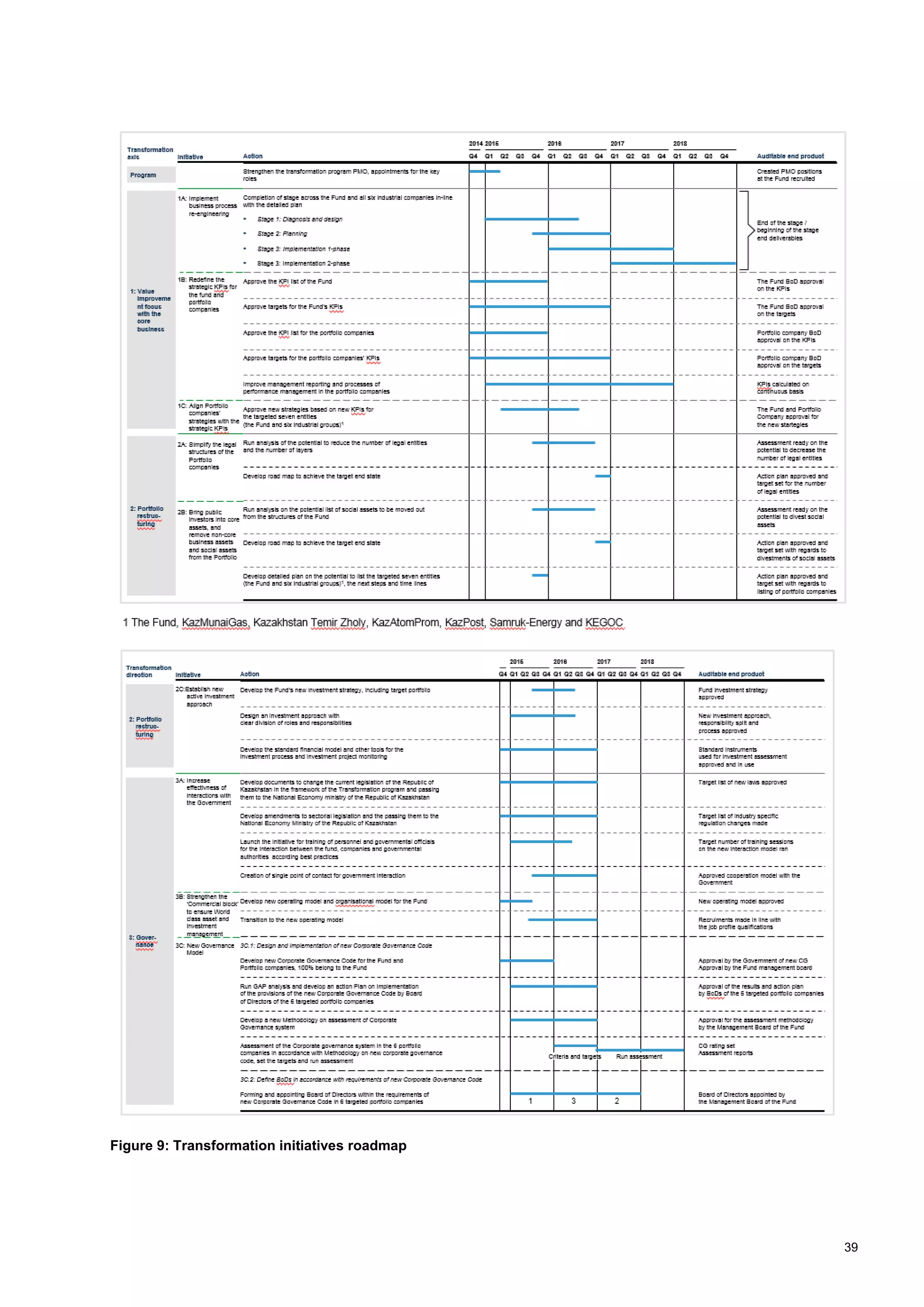
![40
Change management roadmap
The change management roadmap shows the activities meant at facilitating, supporting, and
reinforcing the transformation of the Fund and its portfolio companies. These activities will
start with the Fund in Q4 2014 and then cascade onto portfolio companies at the end of Q1
2015. At the Fund level, top management will begin by developing a transformation story
and an internal two-way communication plan. Top management will spearhead the
transformation by continuously role-modeling the new behaviors. By conducting employee
assessments, management will identify potential leaders who will then be trained to become
change agents who will drive the transformation.
When transformation kicks off at portfolio companies in Q1 2015, the transformation story
will be cascaded through these organizations, supported by extensive communication, both
internally and externally. The required new skills will be built through extensive training.
Best practice examples will be diligently collected and widely shared within the Group. As
the transformation progresses, its results will be reinforced through changes in the
organization structures and processes and codified in internal books and policies. [Figure 10]](https://image.slidesharecdn.com/samruk-kazynatransformationprogram-170203091723/75/Transformation-program-41-2048.jpg)
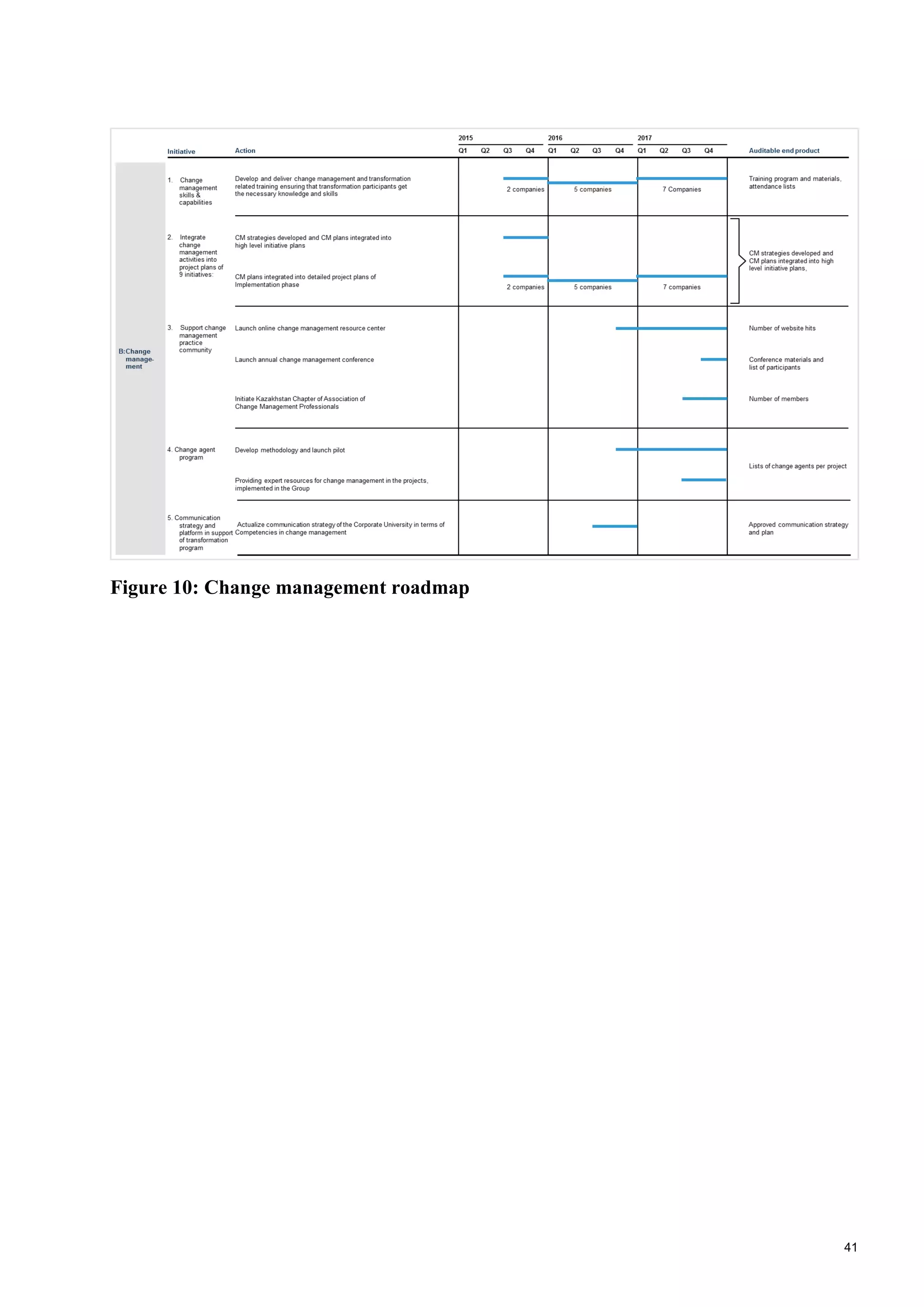
![42
5. Program Management and governance
Key messages of this chapter:
■ As the transformation program moves to the next stage of implementation
existing program management structures should be adjusted to reflect
additional scope and scale requirements.
■ Samruk-Kazyna Transformation Project Management Office at the Fund level
ensures the success of the transformation program through monitoring of
progress, reporting, centralized guidelines development and expert support to
the owners of initiatives.
■ Effective operation of PMO will require resources (both people and monetary)
and governance mechanisms (regular meetings, opportunity to elevate
resolution of key decisions to the steering committee).
As Samruk-Kazyna transformation program transitions from the current business process re-
engineering focused phase to include also more strategic levers, the program governance
should be updated to reflect the additional scope and complexity. The original program
management footprint established to serve the operational transformation should be continued
going forward:
■ One Samruk-Kazyna transformation program PMO at the Fund level (core
transformation team which is responsible for supporting the whole transformation and
for transformation at the Fund level)
■ One PMO within each Tier 2 portfolio company (responsible for supporting the
transformation in portfolio companies)
Samruk-Kazyna Transformation Project Management Office (PMO) mandate is to support
the Fund and the portfolio companies in implementation of the transformation program
through:
■ Development of common guidelines in high value / high risk areas despite the diversity
of the portfolio companies business activities
■ Expert support to initiative owners on implementation and challenge them on the content
decisions
■ Tracking and progress reporting against the planned timelines and targets at the Fund
level
■ Content development for the communication related to the transformation program
■ Organizing key meetings in-line with the planned working rhythm
To deliver on this mandate the Samruk-Kazyna Transformation PMO should consist of a team
of 10-15 full time employees [Figure 11] led by Transformation Program Director. The role
that these people play should be divided into three categories: Project management related
roles, cross cutting methodological and CxO councel / Business Process Owner –type of roles.
Each of these people would be interacting with external resources on as needed basis in order
to get specific expertise or capacity during a certain moment during the project.](https://image.slidesharecdn.com/samruk-kazynatransformationprogram-170203091723/75/Transformation-program-43-2048.jpg)
![43
Figure 11: Roles and responsibilities in the Samruk-Kazuna Transformation PMO
The Samruk-Kazyna Transformation PMO would interact with the other parties in the
following way [Figure 12]:
■ When developing the common principles and cross cutting methodology, they would
collaborate systematically with the initiative owners in the Fund and in the portfolio
companies to collect input, discuss the key choices, get portfolio company specific
understanding and share global best practice experience. This would ensure highest
possible quality as well as buy-in from the different parties. Common principles cross
cutting methodology gets approved by Transformation Steering Committee, after which
they get implemented by the initiative owners with the support and quality control of the
Samruk-Kazyna Transformation PMO resources
■ When providing expert support for the initiative owners, either by themselves or in
combination with external resources, they would interact either directly or in
combination with the portfolio company PMO. This model of working could include
either content related guidance or very hands-on support to solve one-off challenge or
for a short period of time to accelerate the development in a critical areas
When doing tracking & reporting the progress, at the Fund directly collecting the status
information from the initiative owners and with regards to the portfolio companies from
the portfolio company specific PMO, which would collect it in their own portfolio
company. Tracking and reporting will be done both against the deliverables and
deadlines, by assessing compliance to the agreed guidelines and cross-cutting
methodology, as well as against the expected results
Roles
Transformation
program director
Communication
Key Responsibilities
▪ Provide day-to-day leadership for the operations of the program
▪ Coordinate resources and schedule with senior management
▪ Escalate and resolve problems in Fund and/or Portfolio companies
transformation
▪ Develop communication master-plan (internal and external)
▪ Spark change – energize organization(s) around compelling vision for
change, celebrate achievements, and build/maintain momentum
▪ Develop communication content and communicate impact of change
▪ Define guidelines for HR processes and people related changes
▪ Ensure compliance to common principles, help to solve problems
▪ Define the methodology for business processes reengineering including
process mapping, and definition, technology enablement, etc.
▪ Provide expert knowledge to initiative owners
▪ Coordinate usage of external resourcing
Management
accounting
▪ Define guidelines for management accounting, finance function and treasury
transformation
▪ Help to transform investment case modeling
HR / people
processes
Business
Process Re-
engineering
methodology
Tracking and
reporting
▪ Keep the transformation on track by actively monitoring completion of
deliverables
▪ Communicate progress during status meetings
▪ Define guidelines for establishing procedures for purchasing
▪ Provide expert knowledge to optimize high priority cost categories
Purchasing
▪ Perform assessment of best practices for delayering of legal structures
▪ Provide expert support regarding legislation changes for transformation
Legal
Project
management
Methodological
support
CxO counsels,
content experts
in high value
areas critical to
implementation
Role type
Change management
facilitator
▪ Manage the change management part of the transformation
▪ Facilitation of application of change management tools and instruments
Technology
enablement
▪ Define approach towards IT and other technology enablement
▪ Provide expert opinion on technology solutions related to core processes](https://image.slidesharecdn.com/samruk-kazynatransformationprogram-170203091723/75/Transformation-program-44-2048.jpg)
![44
Figure 12: Transformation program governance model
Main responsibility on following up the progress and results of the transformation follows the
normal lines of the corporate governance, i.e., transformation program related progress
reviews within the portfolio companies happen at the management board and portfolio
company board of directors levels, and similarly at the Fund level the Fund’s management
board and the Fund’s board of directors. In order to ensure coordination and boarder
transformation program related discussions there should be regular monthly meetings
between the Samruk-Kazyna transformation PMO and the portfolio company PMOs, and
quarterly between the Fund top management and the portfolio company top management in
Modernization board meeting [Figure 13].](https://image.slidesharecdn.com/samruk-kazynatransformationprogram-170203091723/75/Transformation-program-45-2048.jpg)

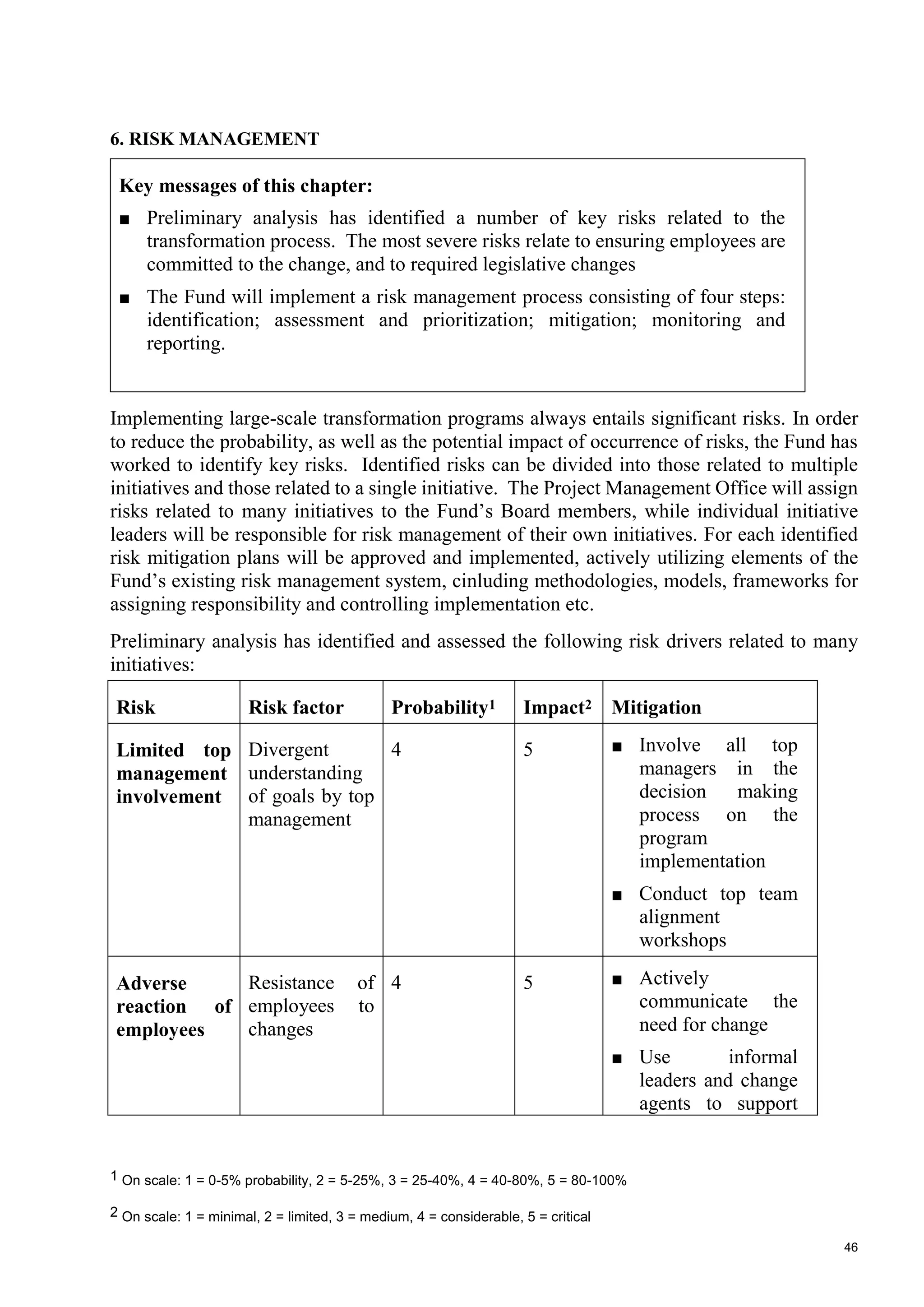
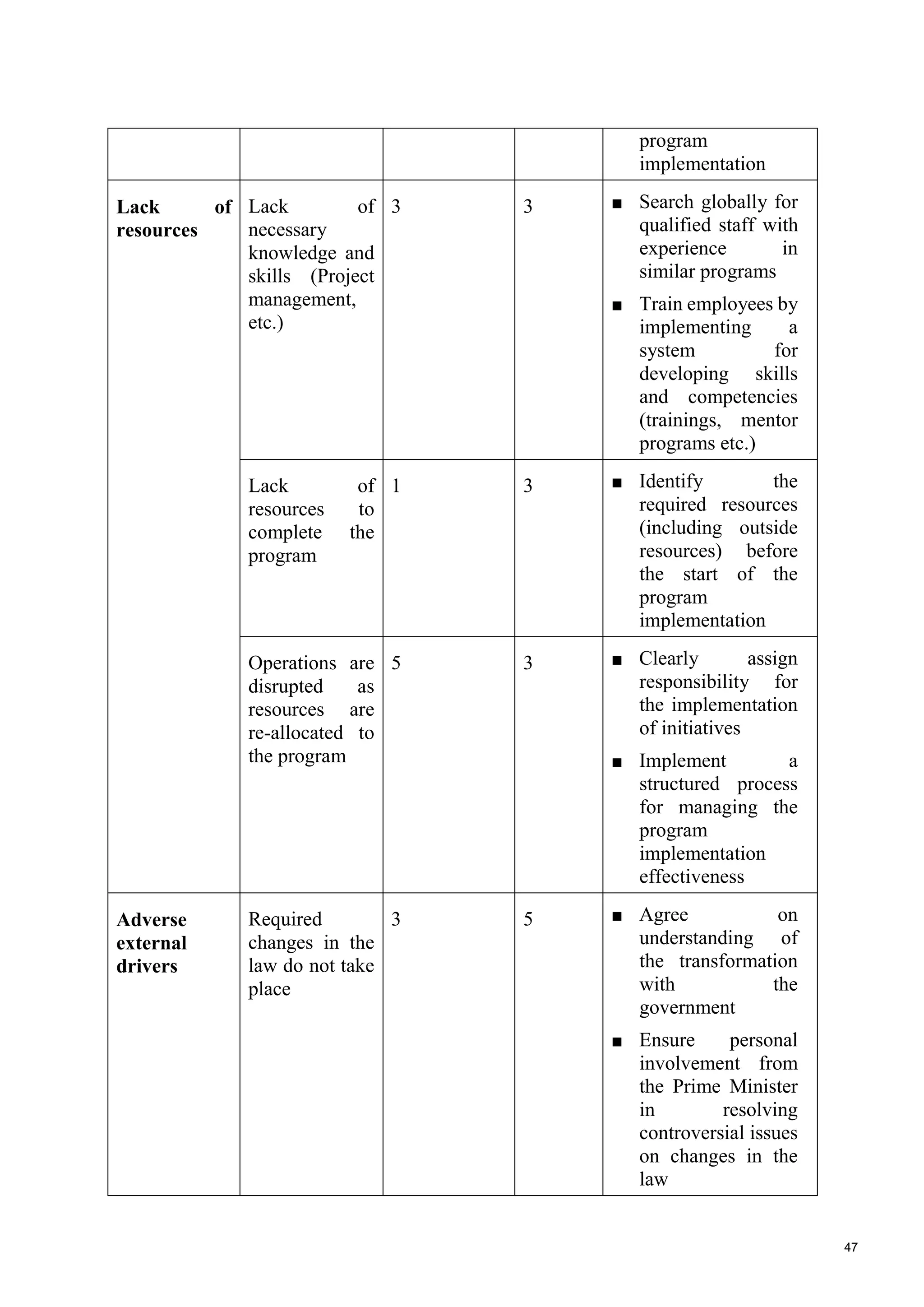
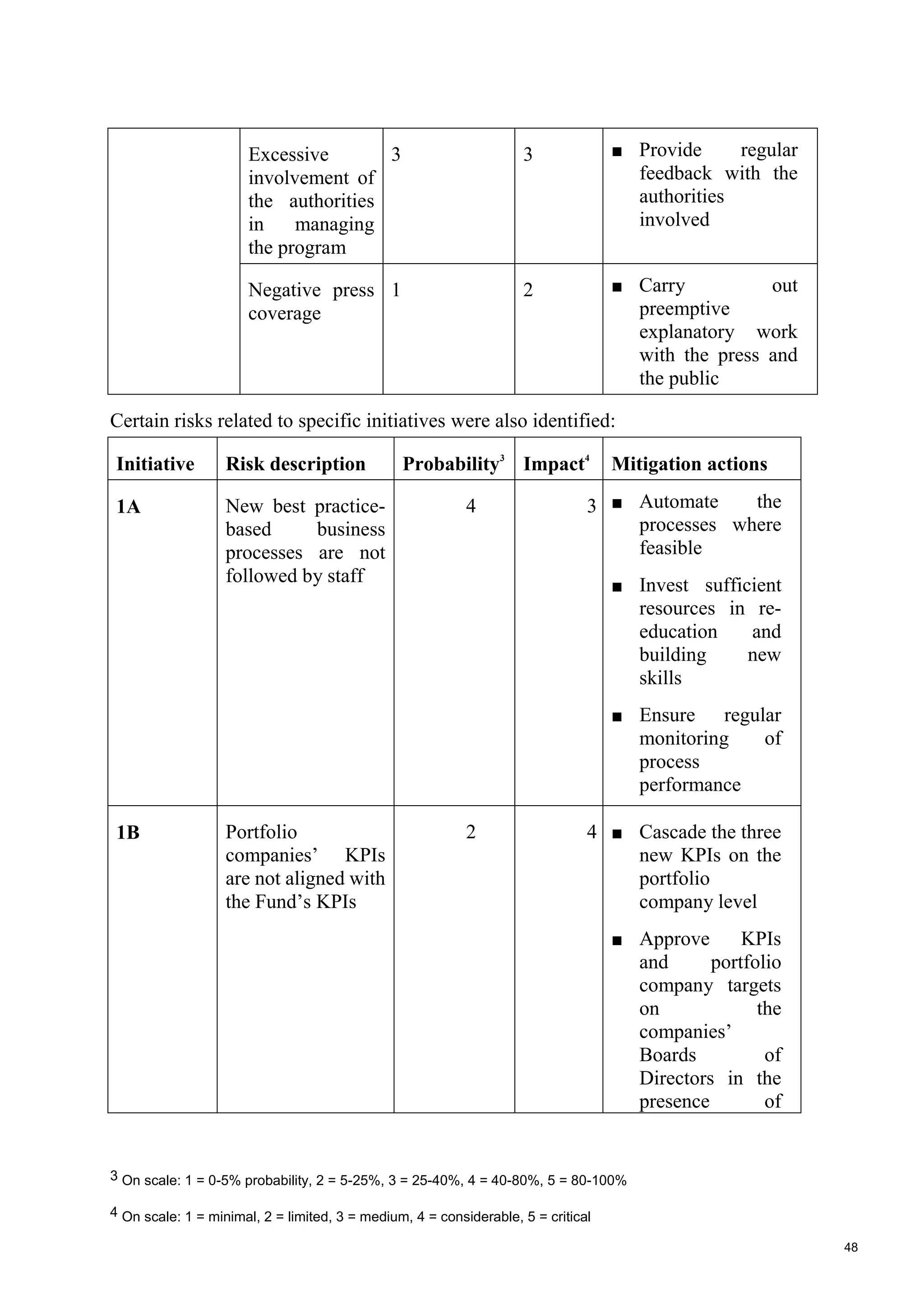
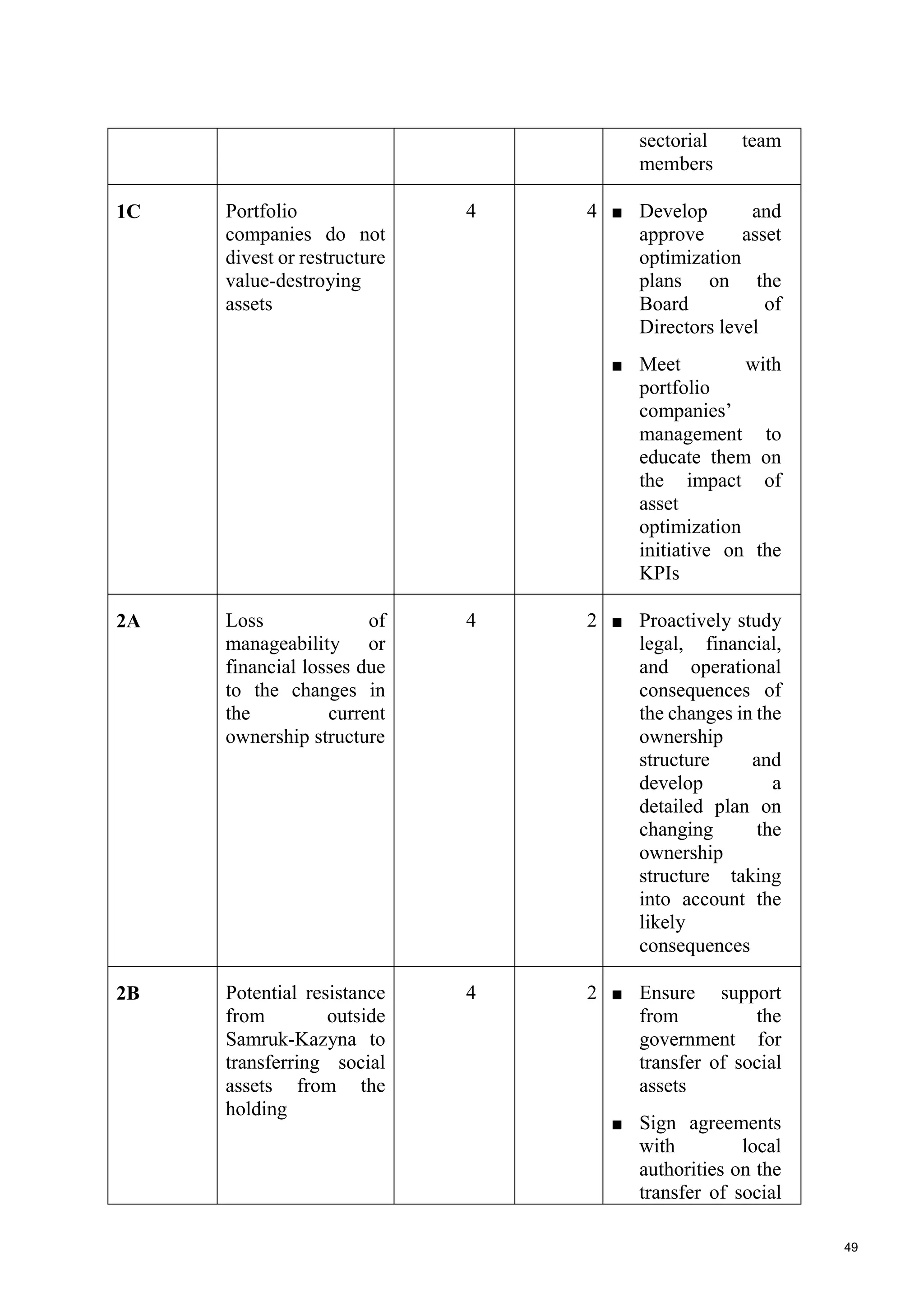

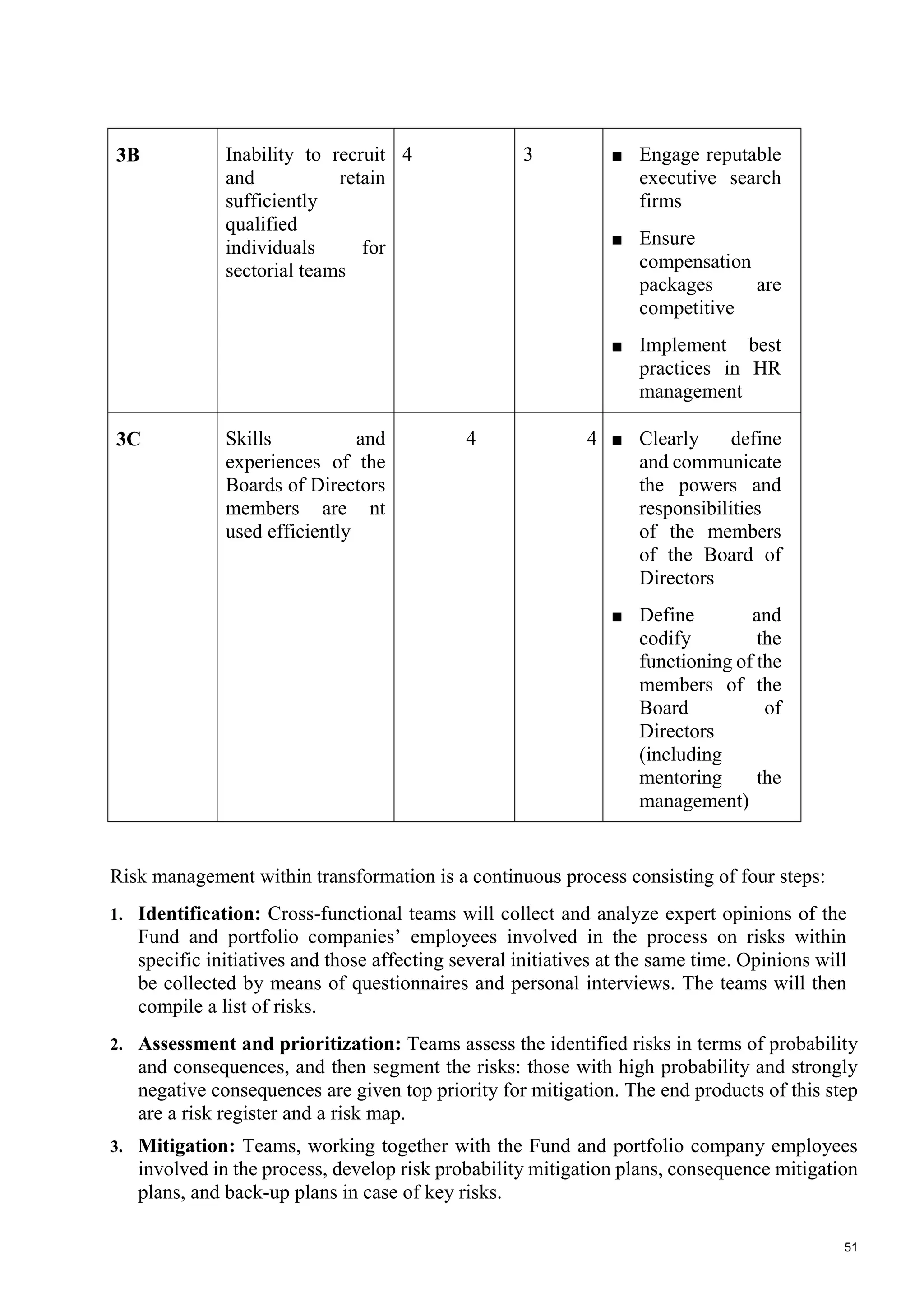
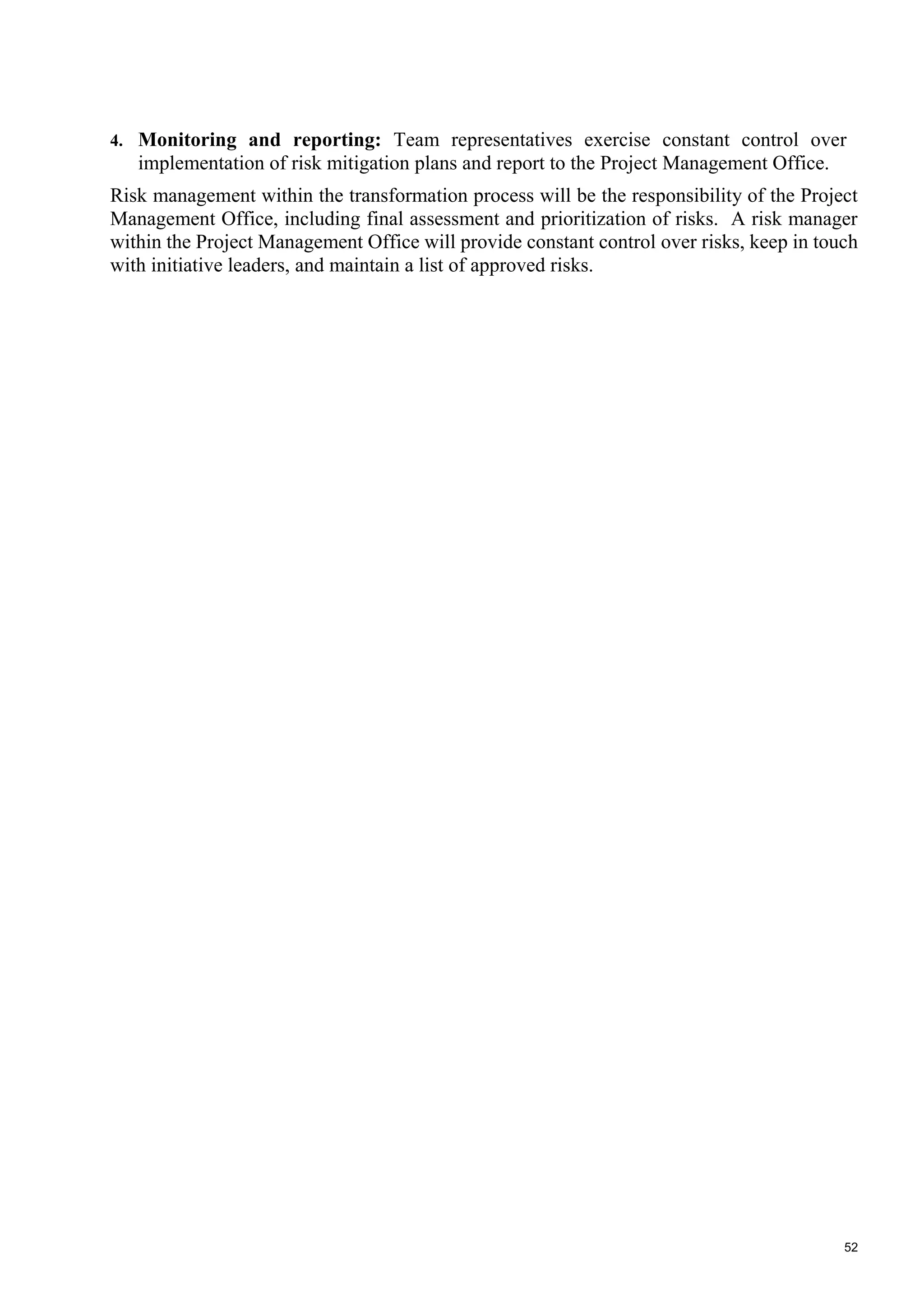
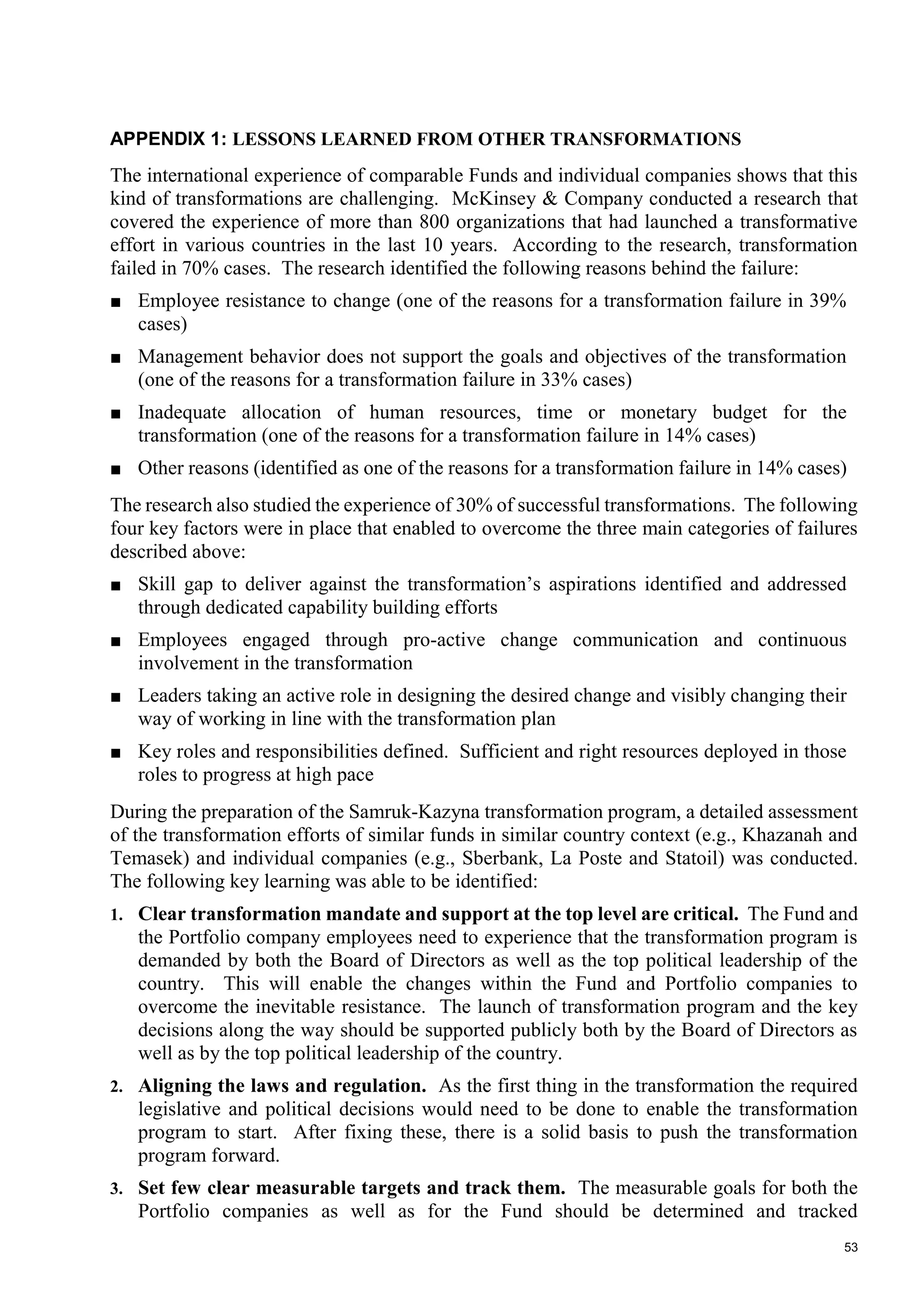
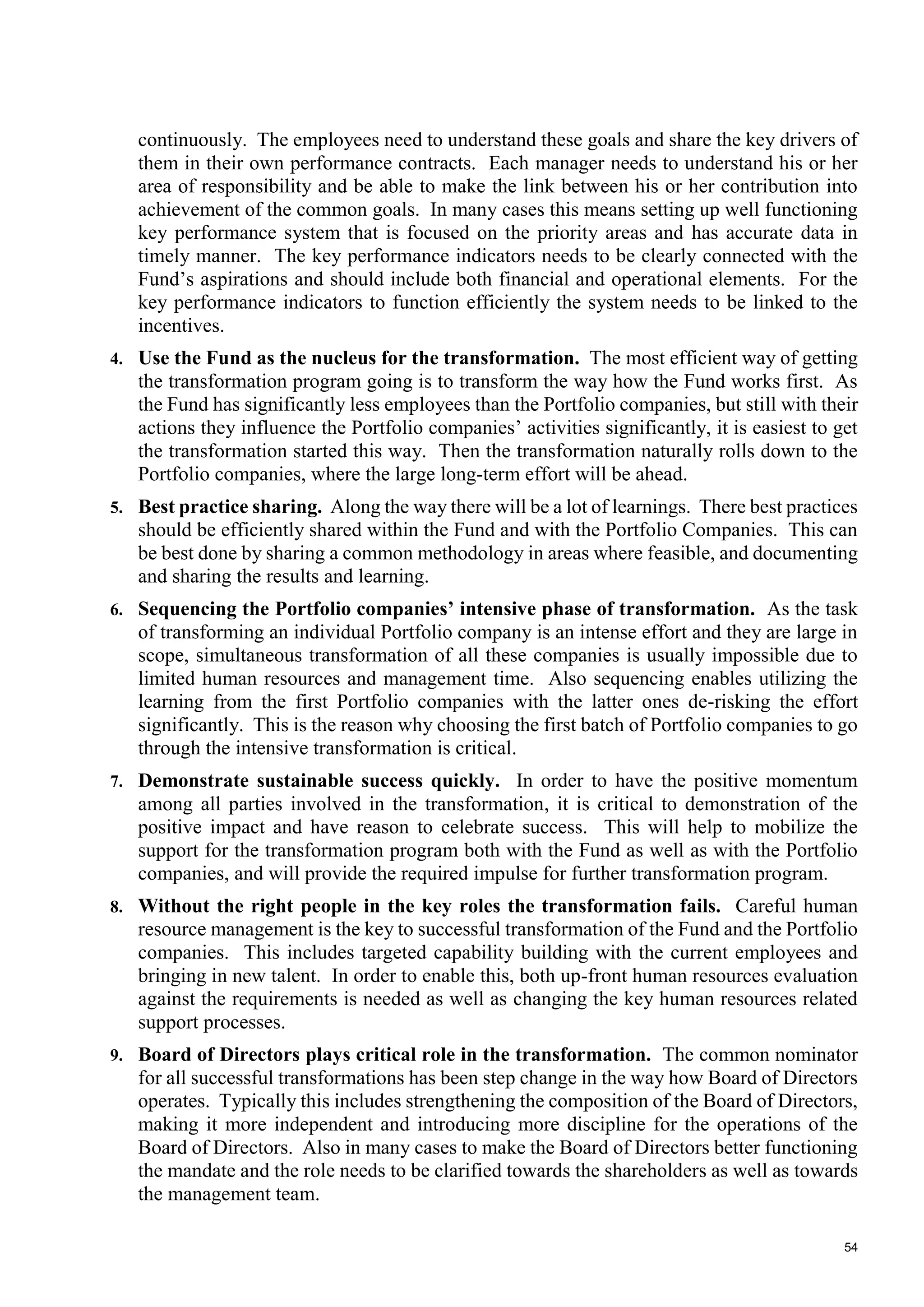
![55
Establishing dedicated transformation office. Given the intensity of the transformation as
well as the special requirements, a dedicated transformation office structure should be
established to track the progress with the transformation, share common methodology in
certain areas of change management (e.g., approach towards defining the processes) and
manage certain shared activities (e.g., communication). The transformation office should be
granted with the required authorities and resources, and the key roles in the transformation
office should be staffed with personnel having the appropriate skills and experience.
Among transformations that have been successful, there are case studies to learn from both in
terms of similar sovereign wealth funds that are active strategic holding companies (i.e.,
Mubadala, Khazanah and Temasek) that are relevant for Samruk-Kazyna as a Fund especially
as well as individual Portfolio companies (e.g., Sberbank, La Poste and Statoil). ) that are
relevant for the Samruk-Kazyna Portfolio companies. Of all the case examples available, two
most comparable case examples are described more in detail [Exhibit 10]:
■ Khazanah is a Malaysian sovereign wealth fund that was able to transform itself from a
passive holding company with negative economic profit into an incubator of regional
champions and a catalyst for a nationwide transformation. The context as well as the
aspiration level related to Samruk-Kazyna’s transformation is very similar to Khazanah.
[Exhibit 11]
■ Sberbank, a Russian bank, was able to transform itself from an inefficient company into
a leading edge bank by piloting Lean techniques and technology-enabled business
processes in selected areas, and then rolling them out across the company. Being from
the CIS region and having a similar legacy to many of the Samruk-Kazyna Portfolio
companies Sberbank is a good example of successful individual Portfolio company
transformation. [Exhibit 12]
Khazanah: A successful sovereign wealth fund transformation that catalyzed an
entire country
In 2004 Khazanah was a small unit administering Malaysian state-owned assets as a passive
shareholder. The focus of its activities was on processing dividends and collecting reports.
It did not actively buy or sell Portfolio companies, nor did it use its ownership position to
influence Portfolio company performance. Management at both the Khazanah fund level and
at Portfolio company level was dominated by former political figures. Many companies were
showing positive net profit, but compared to their industry peers they were lagging and out of
the 15 largest companies only seven showed positive economic profit. For Malaysia as a
country Khazanah’s poor performance created a major obstacle, since the Portfolio companies
made up 75% of market capitalization in the stock exchange and 1.5 million employees.
This situation motivated Malaysia’s Prime Minister to embark on a large scale transformation
of Malaysia’s economy with a target for to transform Khazanah into “one of the biggest and
most dynamic investment houses in the region” that will help to make Malaysia globally
competitive by catalyzing economic growth, boosting nation-wide competitiveness and
cultivating high performance. The transformation of Khazanah can be split into four periods.
Phase 1: Diagnostics, planning and mobilization (2nd
half of 2004 – 1st
half of 2005)](https://image.slidesharecdn.com/samruk-kazynatransformationprogram-170203091723/75/Transformation-program-56-2048.jpg)
![56
In June 2004, the newly appointed Managing Director for Khazanah, Dato’ Azman Mokhtar
received a strong mandate to restructure the fund and launch a change process. The Board of
Directors also promised their long-term commitment for the transformation – even when it
was explicitly discussed that the transformation would require many politically unpopular
moves (e.g., decreasing headcount in Portfolio companies, replacing key individuals and
tweaking regulation) and that economic performance would dip before it started to improve
due to one-off effects. This prediction turned out to be correct (economic profit dropped from
negative RM1000 million to negative RM5000 million before turning significantly positive
two years later) and in the early years lay-offs and changes in the key positions were required.
The main actions taken in the first phase included:
■ Revamping the Khazanah fund-level organization: Khazanah’s capabilities at the
time did not match the ambitions set by the nation’s leadership. In order to attract best
talent, restrictions on salary and limitations on previous linkages to the civil service were
removed, and a significant portion of total compensation was linked to individual
performance. A significant number of new hires were foreign specialists, who brought
global sectorial and investment expertise. Many of the new, senior employees served in
expanded sectorial teams, which were assigned with responsibility to create an
independent fact base on the Portfolio companies’ performance, support Khazanah
representatives on the Portfolio company Boards, source new investments within their
sectors and partner with Portfolio companies to execute M&A transactions
■ Clarifying and establishing a clear mandate for Khazanah: The Managing Director
was rapidly able to gain agreement on the mandate of Khazanah. It consisted of both
streamlining the legacy investments, transforming the business performance, making
investments in new strategic sectors and actively developing human capital for the
nation. Since the agreed Khazanah mandate consisted of both financial and
developmental goals, the team established a process whereby potential projects are
assessed against financial goals and efforts are made to quantify non-financial
developmental goals. In particular, Khazanah started to evaluate and quantify potential
non-financial impact such as contribution to GDP and number of jobs created, which
would then be used to assign a discount to investment hurdle rates
■ Establishing key performance indicators (KPI): Khazanah established a focused KPI
system to assess the performance of the fund’s sectorial teams, on, which the fund
management’s compensation was based. The KPIs for the sectorial teams were based
on the following principles:
– Value creation based on Economic Profit [(Return on Invested Capital – Weighted
Average Cost of Capital) x Invested Capital)]
– 1-2 key operational metrics specific to each sector, e.g., System Average Interruption
Duration Indicator (SAIDI) in the power sector
– Milestones or projects (e.g., completion of projects / investment deals or talent
development within the sectorial team)
■ Reforming Board composition: Many of the Boards were diagnosed as dysfunctional,
with substantial trust issues. Given the situation in chosen pilot companies, a Lead
Director (representing the largest shareholder) was appointed to guide a Board
Performance Improvement program, with the Company Secretary driving day-to-day](https://image.slidesharecdn.com/samruk-kazynatransformationprogram-170203091723/75/Transformation-program-57-2048.jpg)
